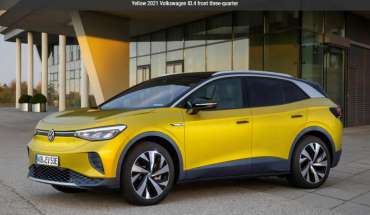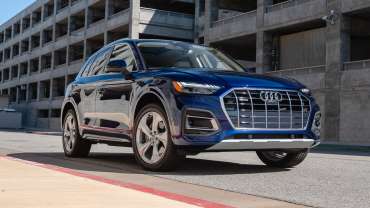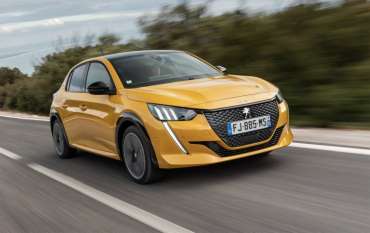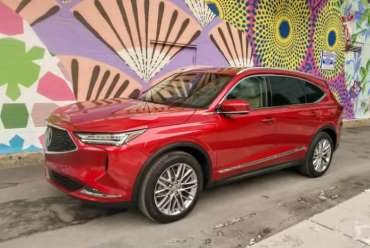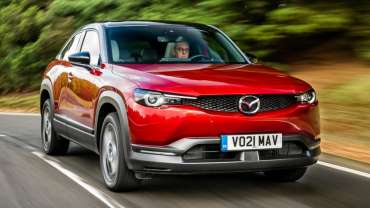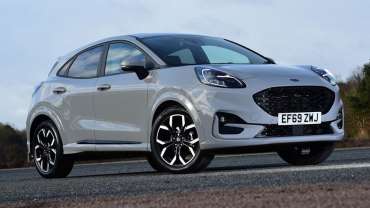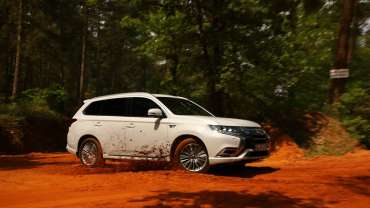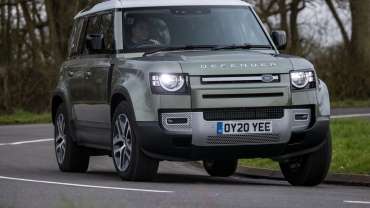Displaying items by tag: SUV
Volkswagen ID.4 review
The Volkswagen ID.4 is a fully electric SUV that is a logical extension of the excellent Golf-sized ID.3 hatchback family. It's on UK sale now, but only as the ID.4 1st Edition initially, costing a hefty £40,800 now that it is no longer eligible for the government's plug-in car grant. Expect a wider range of models, specs and trims to be made available throughout 2021.
Under the ID.4's SUV bodywork is VW's dedicated electric vehicle technology that will be shared with a number of other Audi, Cupra, SEAT and Skoda EVs, such as the Enyaq. The understructure contains all the electric drive components, such as the motor and batteries, and is purpose-built to be as efficient as possible as there are no petrol or diesel derivatives to engineer.
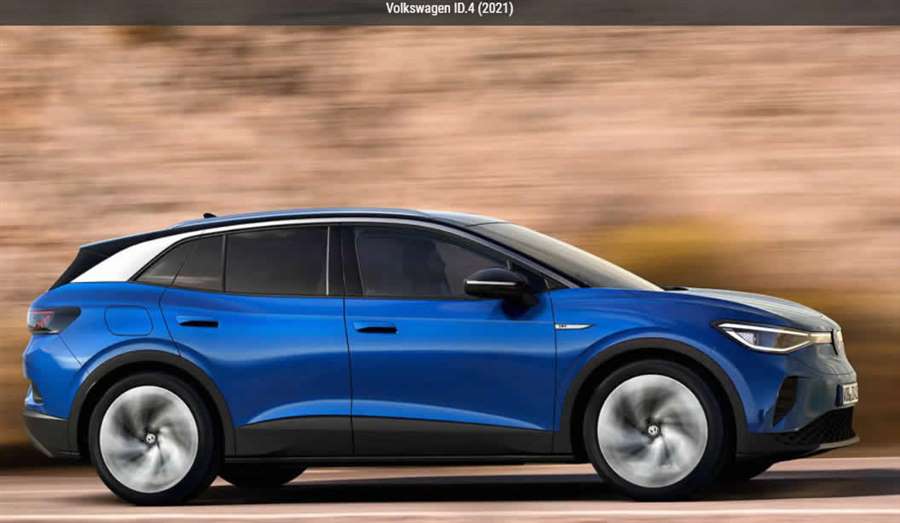
As a result, the ID.4 is even roomier and more practical than the ID.3, despite their close similarities under the skin.
Electric rivals are few and far between, but the smaller Peugeot e-2008 is already in showrooms, and might be worth considering if you don't want to wait for a cheaper ID.4. At the other end of the price scale, the Volvo XC40 Recharge P8 will go up against more expensive ID.4s.
What's under the skin?
Nestled under the ID.4's boot floor is an electric motor that drives the rear wheels. Buyers who need four-wheel drive will have to wait until later in 2021 for models fitted with a second motor to power the front axle. Don't expect the VW to be dazzling off-road, though, even though its ground clearance is usefully high at 21cm.
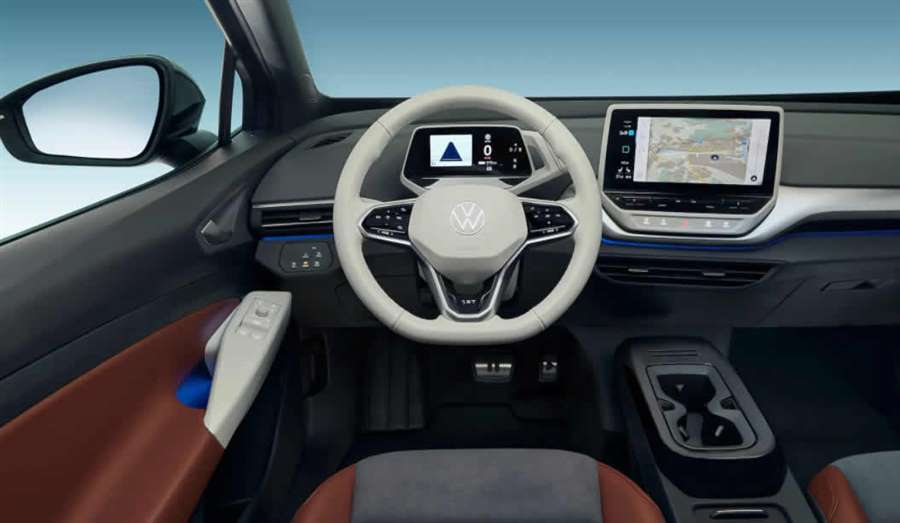
Top speed is electronically capped at 99mph so that battery reserves aren't needlessly wasted driving at extreme speeds, while the 0-62mph sprint takes just 8.5 seconds.
All ID.4 1st Editions come with a 77kWh battery pack giving a claimed range of 310 miles. Although that figure has been achieved using the latest WLTP standards designed to reflect real-world driving, we found the range meter read around 220 miles on a crisp spring morning. Hooked-up to a rapid 125kW public charger, the car's battery can be replenished to 199 miles of range in just 30 minutes.
As the line-up expands, a smaller battery size will come on stream with lower purchase prices to match.
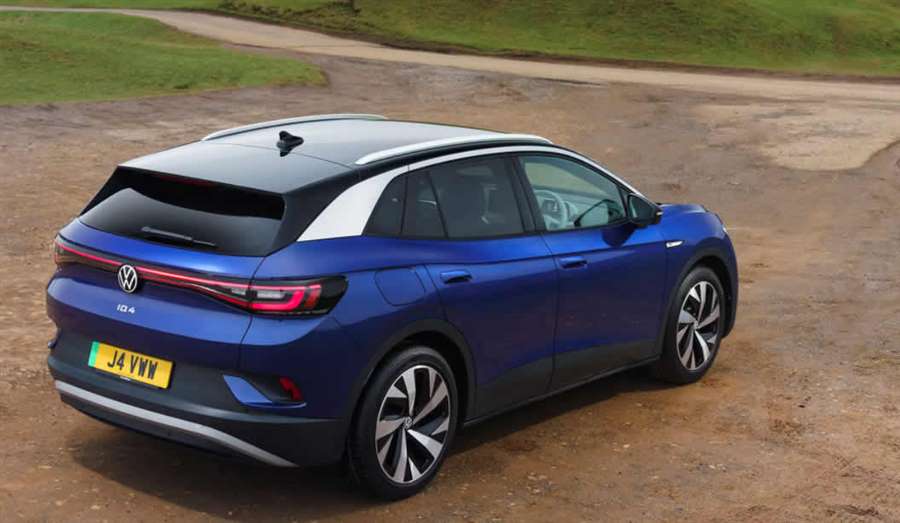
What's the ID.4 like inside?
Thanks to the dedicated EV hardware and lack of transmission tunnel, there's plenty of space for passengers, while you get full digital displays alongside what VW describes as intuitive voice control and touch surfaces to operate most minor functions.
Inside, the interior design theme is essentially the same as that found in the ID.3, even if there's more space inside. It's a clean-looking cockpit with a twist-action gear selector attached to the drivers’ instrument pod and storage cubbies in the centre console.
An augmented-reality head-up display is on the options list, while the connected infotainment system has real-time traffic data, live updates on the state of nearby chargers and the ability to pre-condition your car via a phone app, meaning no need to get into a chilly or frosted-up car on a frozen morning.
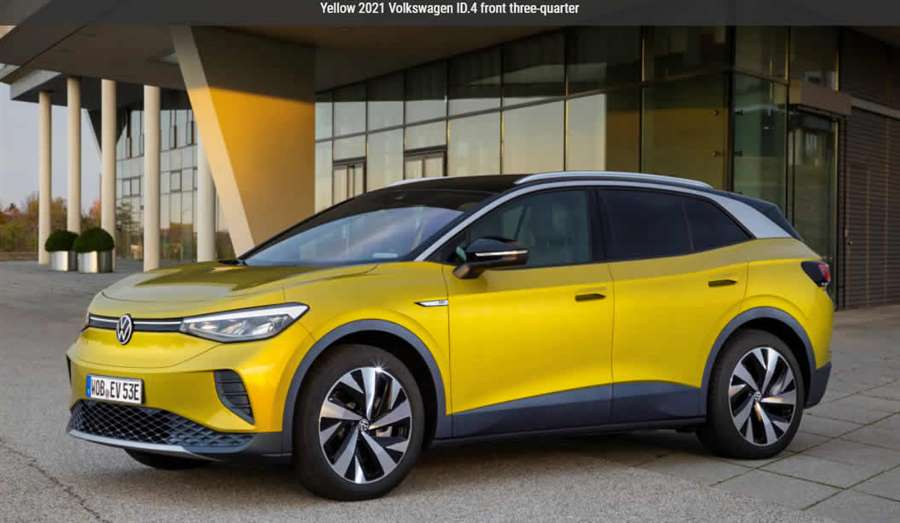
As you would expect, the ID.4 1st Edition is packed with standard equipment, including soft-touch grey and brown fabric upholstery, 20-inch alloy wheels, full LED exterior lights, darkened rear privacy windows, adaptive cruise control, a 10-inch multimedia touchscreen and 30 (yes, thirty!) different colours for the interior ambient lighting.
What's it like to drive?
It's better than its podgy looks might lead you to believe. Thanks to excellent weight distribution and that low-down battery pack, the ID.4 grips and steers very well indeed. Even when fitted with the optional 21-inch wheels and super low-profile tyres, the ride remains compliant on most surfaces, and it doesn’t get too jarring when you switch modes from Comfort to Sport.
This 204hp version isn't as fast as you'd expect, as performance is hampered by a hefty kerbweight of more than two tonnes. It's quick enough for a car of this type and performance is well judged, but we'd warn that lower-output versions may not have enough performance if you regularly undertake long journeys or travel with multiple passengers onboard.
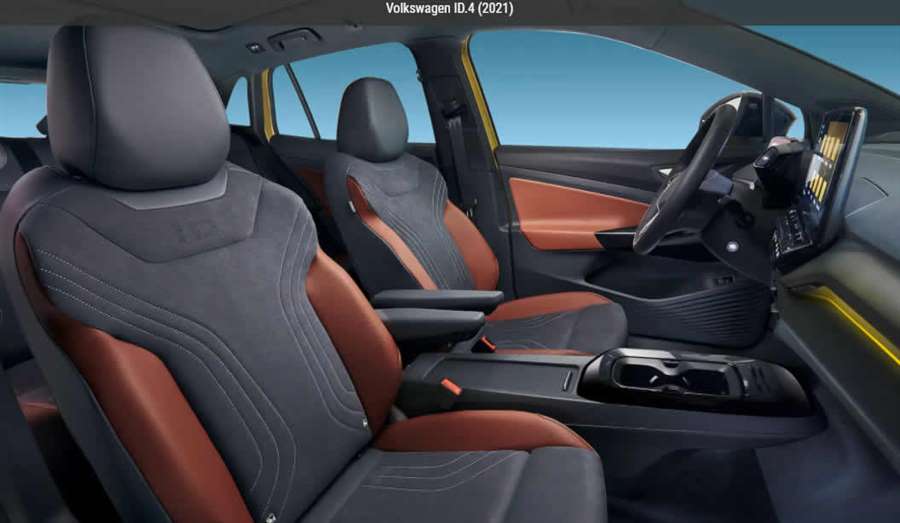
Volkswagen ID.4 (2021) driving, rear viewEnlarge0videoEnlarge22photo
It is quiet, however. This is a really hushed, cosseting drive, and best driven in a more relaxed manner. This will also help the battery range and brings out the best in the comfort-orientated chassis.
There's a toggle switch on the steering column that lets you select the level of regenerative braking on offer. This is a similar system to other electric cars, which allow 'one-pedal' driving, slowing down significantly by lifting off the accelerator, rather than braking conventionally.
For added convenience - and as expected by many SUV owners - a towbar can also be specified for the ID.4, allowing it to haul braked trailers of up to 1,000kg.
Should you buy a Volkswagen ID.4 SUV?
Yes, although it's not perfect. And if we're being honest, it doesn't feel quite as brilliant or refreshing as the Volkswagen ID.3 – the car it's so closely related to. But we'd say it has a more pleasing cabin, and as such the ID.4 feels like the future has suddenly arrived and we largely like what we see.
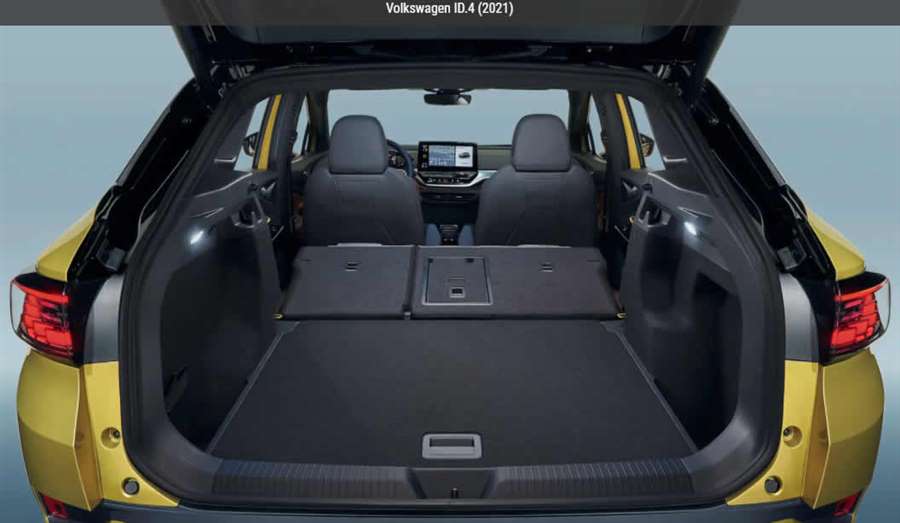
It's a little too early for a definitive verdict as right now, we just get the top-spec 1st Edition model, which weighs in in at £40,800 now that it is no longer eligible for the government plug-in car grant. Following the ID.3's logic, lower powered less well-equipped models will take the ID.4 down into the early £30,000s, which will open it up to far more buyers.
As such, we expect the cheaper, more mainstream models will be much more appealing – this is fundamentally an excellent electric SUV that will undoubtedly fit into the lifestyles of a large amount of families who are yet to buy an EV. The biggest unknown yet to answer is whether we rate the ID.4 ahead of the closely related Skoda Enyaq.
It's had a lengthy gestation, not least because of the Coronavirus (COVID-19) pandemic and some teething issues with the ID.3's software, but right now the ID.4 looks very promising indeed.
2021 Audi Q5 First Test: The Popular Kid Gets a Fresh Wardrobe
Audi’s most popular model gets a midcycle refresh but leaves us wanting a bit more.
Just before 2020 ended, we had the chance to drive the 2021 Audi SQ5, the sportier variant of the Q5 powered by a punchy V-6 engine. Like we noted back then, the SQ5 delivers the best of both worlds. It's a comfortable SUV that's great for everyday driving, but also more dynamic when the road turns twisty. Now, we've driven and tested the 2021 Audi Q5, the toned-down normal version that competes in the compact-luxury-SUV segment, one of today's most popular. As you'd expect, then, the Q5 is indeed Audi's most popular model, making up 25 percent of the brand's sales, with the conventionally powered, non-S version responsible for most of that chunk (the balance includes not just SQ5s, but also Q5 PHEVs).
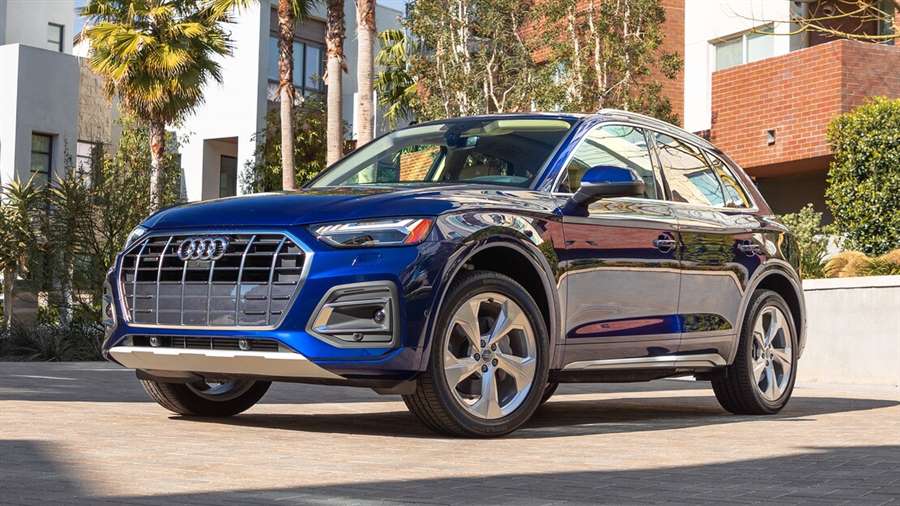
In order to be a popular player in one of the toughest segments, the Q5 has to bring plenty of goodness to the table, no? It combines attractive styling with a well-appointed cabin, all while keeping its prices competitive—something hard to find these days in the luxury game. For the 2021 model year, the Q5 received a midcycle refresh inside and out to bring more glamour and a bit more tech.
2021 Audi Q5: More Soft Than Sporty
As one would expect, the regular Q5 is toned down compared to the S variant, and that was notable during our time with this SUV. Powered by a 2.0-liter turbo I-4 with 261 horsepower and 273 lb-ft of torque, the Q5 employs a seven-speed dual-clutch transmission that sends power to all four wheels thanks to Audi's Quattro system. The engine is mated to a 12-volt mild hybrid system that's new for 2021, and which adds a combined 13 hp over the 2020 model.
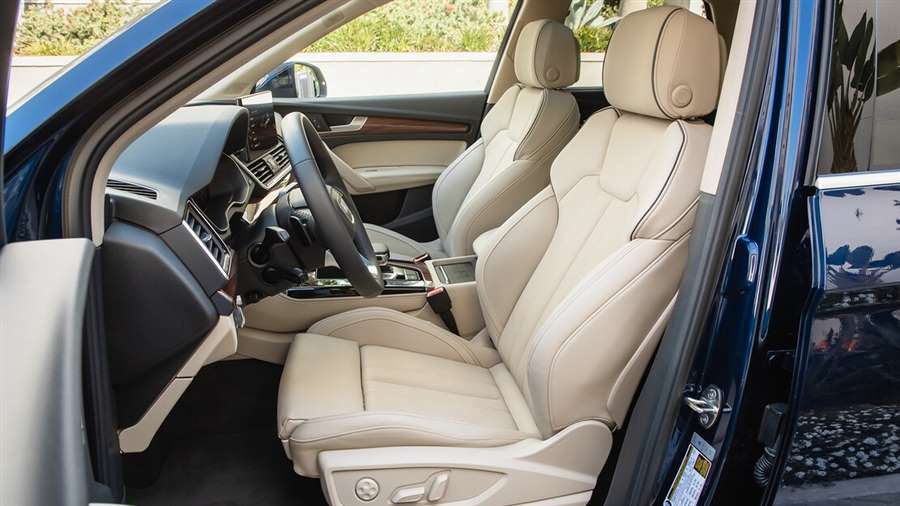
That combination makes the Q5 a decent SUV on the road. The engine is lively, and while it lacks the push of a V-6, it feels completely adequate for an SUV this size. The one complaint we have is with the transmission taking too long to downshift, which we experienced mostly when trying to pass on the freeway. The engine also has a bit of turbo lag, which combines with the transmission issue to compound the sensation that it's weaker than reality when trying to pile on speed or pass another vehicle at freeway velocities. When reaching a cruising speed, though, the Q5 is in its element.
Drivers can choose between five driving modes—Efficiency, Comfort, Auto, Dynamic and Individual. We spent most of the time driving in Auto, but even when we turned on Dynamic mode, the Q5 had the same laggy feel as in Auto or Comfort. Even so, at the test track, associate road test editor Erick Ayapana was able to go from zero to 60 mph in 5.7 seconds, which is a strong number. Pedal overlap causes the transmission controller to launch at about 3,000 rpm, after which gearshifts are much more immediate and aggressive, according to Ayapana. That may be the trick to get an eager start, but it's not how you drive every day. Compared to a 2018 model, the 2021 Q5 was faster to 60 mph by 0.2 second, perhaps thanks to the mild hybrid system.
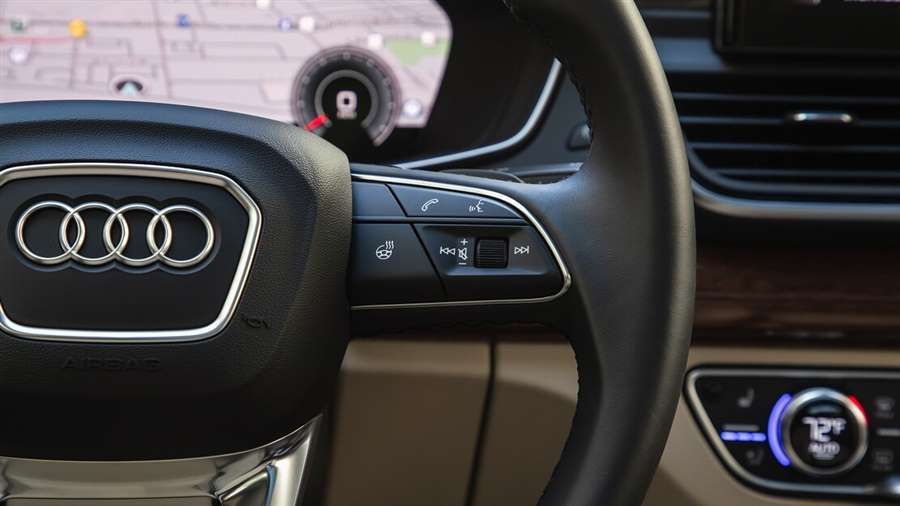
Overall, the ride is settled and comfortable. Whether you drive over harsh pavement or ruts, the suspension does a good job absorbing those imperfections before they get into the cabin. Even on twisty roads, the body is well controlled with little noticeable roll, but chief tester Chris Walton had mixed feelings during our figure-eight test, noting poor body control under braking and cornering. "The transmission, even in dynamic mode with S Drive, was not intelligent enough to hold second gear on the skidpad," Walton added.
Besides increasing power output and (potentially) lowering the Q5's acceleration time, the mild hybrid system also helps with fuel economy. For 2021, the Q5 delivers 23/28/25 mpg city/highway/combined, an increase of 1 mpg in city and combined ratings over last year.
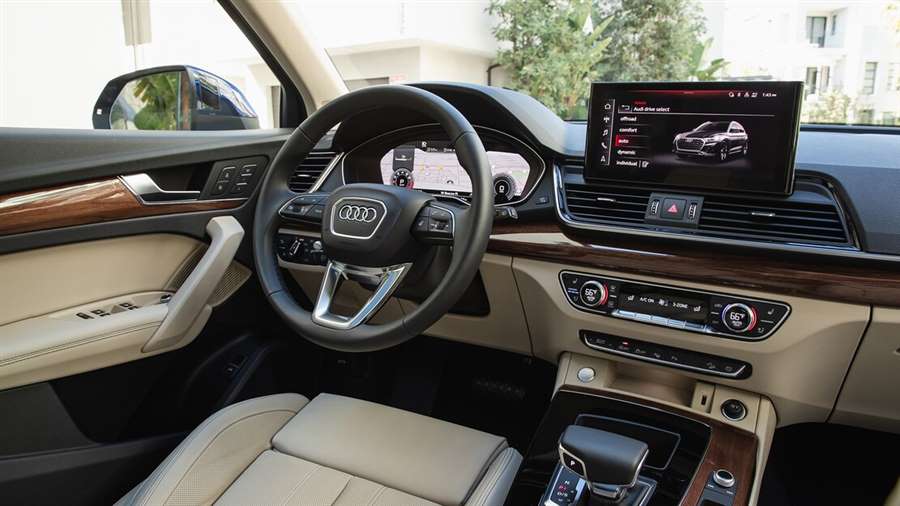
2021 Audi Q5: Comfortable And Elegant
Inside, the Q5 blends a mix of premium quality and high tech. While it doesn't have the same avant-garde interior aesthetic as do the Q7 or the Q8 (these have a two-screen infotainment/HVAC setup on the center console), the Q5 features a 10.1-inch touchscreen atop the dash. It displays Audi's newest infotainment system—MIB 3—which is easy to use and fast to respond. The graphics are top notch, and the way everything is organized makes it easy to get around without having to dig through menus. Apple CarPlay and Android Auto are wireless, and you can use voice commands to do unusual things like change the temperature or other settings in the car.
Our Prestige model—the Prestige trim costs $10,700 over a base Q5—checked pretty much every available box, which included everything from the 19-speaker Bang & Olufsen premium audio system with 3D sound to Audi's "virtual cockpit," whereby a 12.3-inch display serves as the instrument panel and can show real-time Google Maps graphics. Our model also came with other goodies like a head-up display, a 360-degree bird's eye view camera system, and a panoramic sunroof.
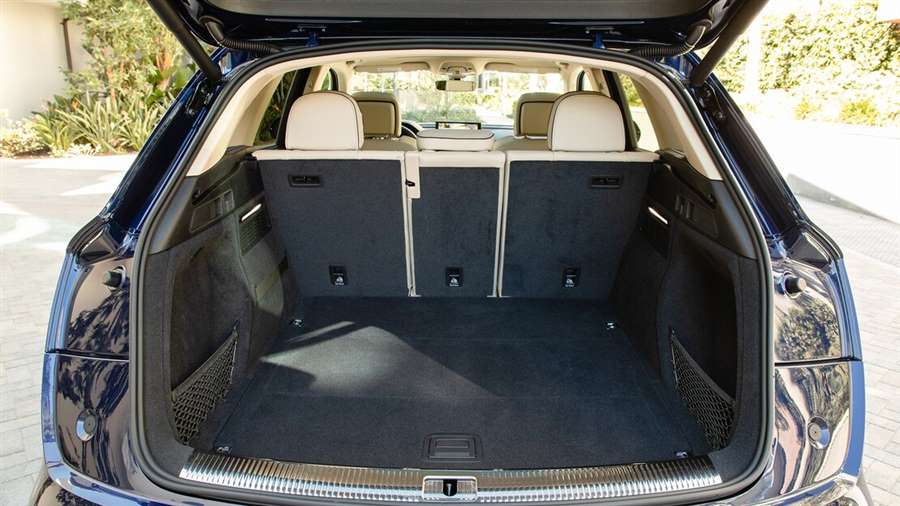
To maximize comfort, Audi also offers heated and cooled front cupholders, heated rear seats, heated and ventilated front seats, and a heated steering wheel. The second-row seats fold almost flat in a 40/20/40 configuration, making it ideal to fit long items between the seats while maximizing passenger space.
And you'll want to maximize the room, as interior space is one of the areas where the Q5 needs to improve. Second-row legroom is a tad tight for adults with long legs. At six feet tall, this author's legs touched the back of the front seat with the driver's seat set to his driving position. Though there weren't any problems with headroom, the noticeable drivetrain hump also interferes with foot room whenever you have three passengers in the rear.
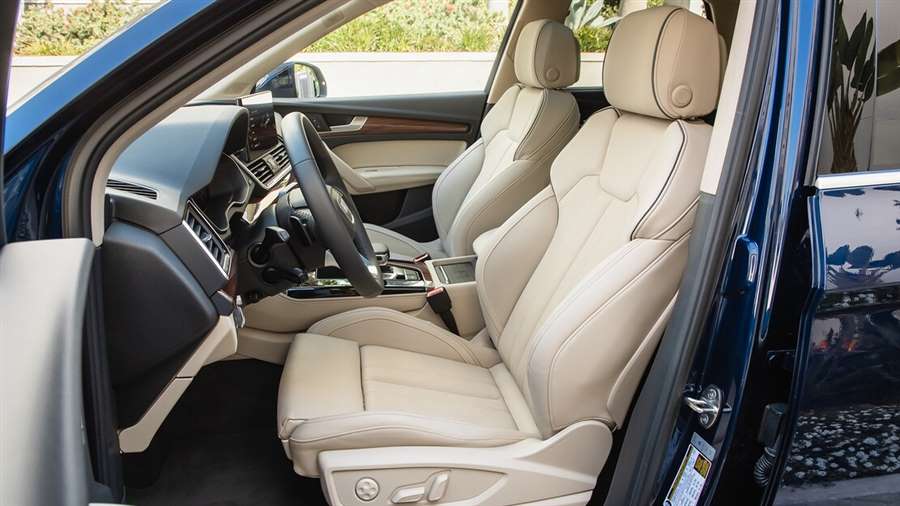
2021 Audi Q5: Safety Tech
Like some other luxury brands these days, the Q5 brings some standard safety systems but charges extra for others. Blind spot monitoring with rear-cross traffic alert, lane departure warning, and parking sensors are standard across the lineup, but adaptive cruise control with traffic jam assist is only available with the Premium Plus and Prestige packages—the two (out of three) highest trims.
These safety systems work well enough on the highway, keeping the Q5 centered in its lane even when lane markings weren't totally clear. We'd like to compare the Audi's systems to those from BMW and Acura, which are among the tops in the segment, to see which truly stands out.
Is The 2021 Audi Q5 Worth It?
Our Audi Q5 Prestige checked out at $56,840, a pricey ask no matter how you look at it. That's several thousand dollars more than a loaded Acura RDX or Lexus NX, but is in line with its loaded German counterparts. Should you have a tighter budget, the Q5 starts at $44,395, with the middle-tier Premium Plus package adding $4,800.
Despite the somewhat lazy-feeling powertrain, it's easy to see why the Q5 is Audi's most popular model. After all, most folks won't stand on it like we do during our holistiic evaluations, and this compact luxury SUV serves up tons of amenities, a well-appointed cabin, and fresh styling that should continue to resonate with a lot of customers. The Q5 is far from perfect, but it does a lot of things well and we can't see this newer version giving up much ground to BMW, Mercedes, Acura, and friends.
These are the best-selling models in Europe: Peugeot has overtaken VW
After last year's drastic decline caused by the pandemic, this year we are witnessing great changes in the European market. First of all, we mean that the eternal European bestseller VW Golf is now only in third place. In front of it are, no less you niches, than two models from Peugeot.
As reported by JATO Dynamics, in a market that is down 20%, there has been a sharp rise in the popularity of electrified cars. During February, 115,000 electric vehicles (EV) and plug-in hybrids (PHEV) were sold, which is a share of an excellent 13.6%, reports Index. Recall, a year earlier, in the run-up to the pandemic, the share of electrified vehicles was only 6.5%.
Several companies are above the industry average, including Hyundai (16%), BMW (24%), Daimler (27%), Jaguar Land Rover (31%) and Geely (45%). Of course, Tesla Motors is at the top with a 100% share of electrified vehicles in sales. It can be seen from the report that Jaguar Land Rover came the furthest from the traditional brands in the electrification of the range.
The best-selling electric model in Europe is the Tesla Model 3, with 5,400 units sold and a 55% share. Second is VW ID.3 with 3,557 registrations, and third is Renault Zoe with only 10 copies less, but also a drop of 45%.
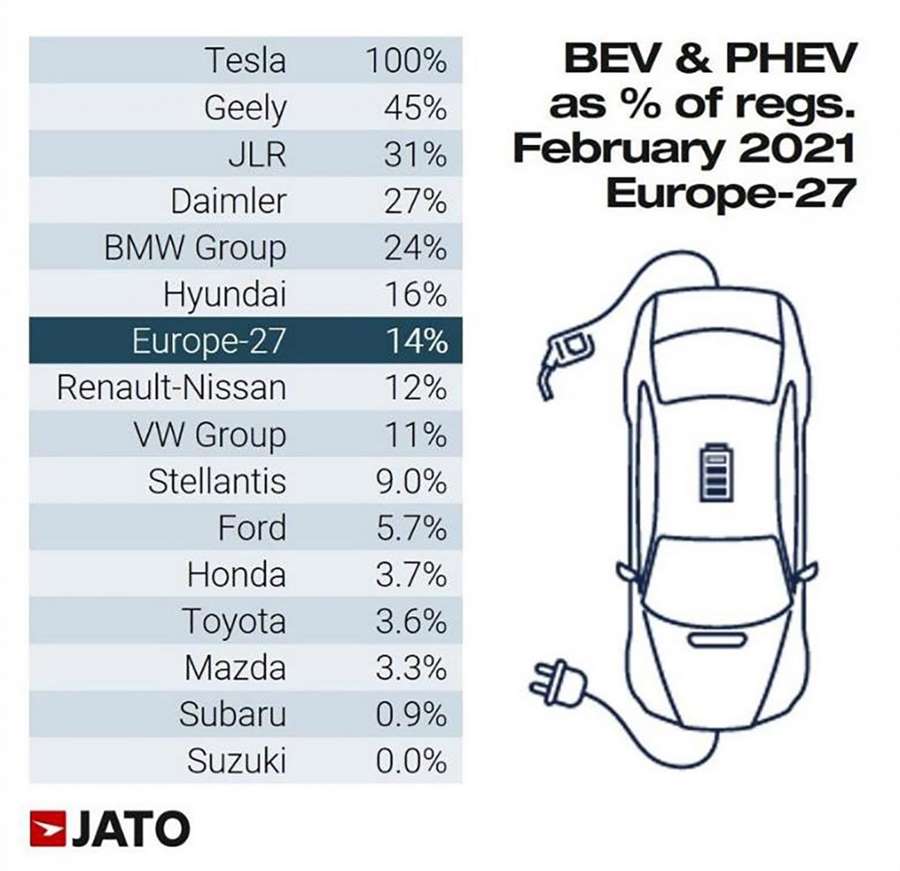
In the PHEV segment, ie plug-in hybrid vehicles, the most popular is the Volvo XC40 with 3,479 units sold, but also with a growth of an incredible 323%. They are followed by the hybrid Peugeot 3008 and Renault Captur with about a thousand copies less. The only market in Europe where electrified vehicles are more popular than traditional ones is Norway. Believe it or not, their share is as high as 79%.
At Peugeot, they are certainly pleased because the best-selling car in Europe is the Peugeot 208 with over 18,000 units sold. It is followed by the 2008 Peugeot crossover, with 17,120 sold, and only in third place is the VW Golf with 16,185 units sold and a drop of 34%.
Take a look at the table and who else was on the Top 10 list for February in Europe.
Segment sales overview - SUV models are still the most sought after.
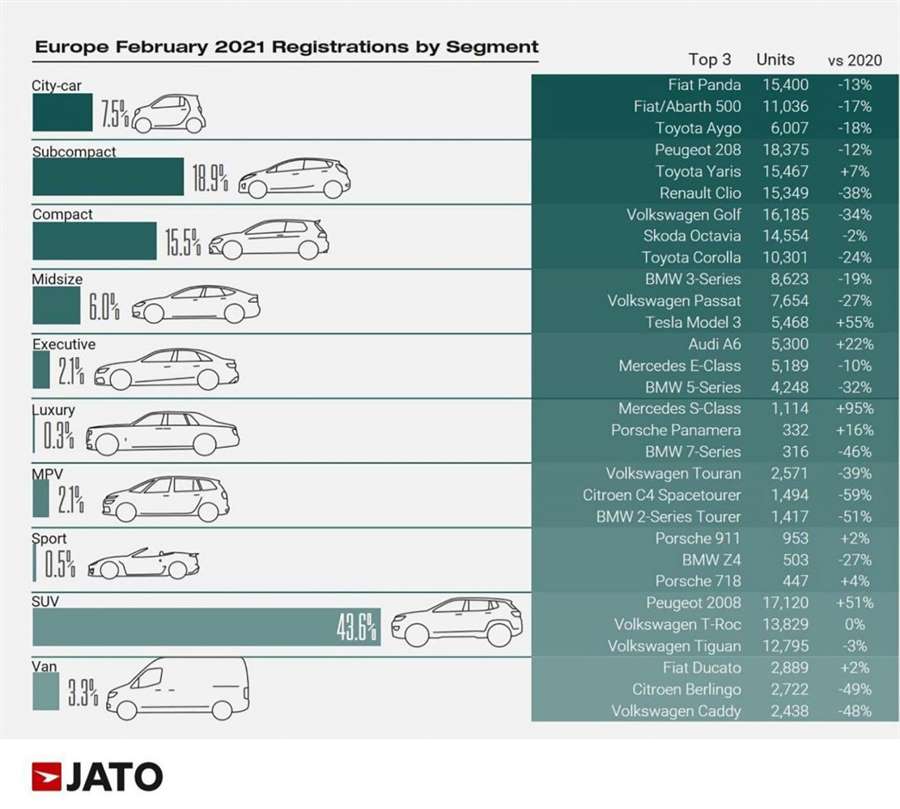
2022 Acura MDX: 5 Things We Like and 3 Things We Don’t
The 2022 Acura MDX is a fresh take on a luxurious three-row SUV that squares off against strong rivals such as the Lincoln Aviator, Lexus RX, Genesis GV80 and Infiniti QX60. Where the new and improved MDX shines is in value. Even with a starting price of more than $47,000, the 2022 MDX comes standard with loads of safety features and updated tech touches, including wireless Apple CarPlay and Android Auto.
Inside, Acura’s engineering team focused on creating a more functional and flexible place to spend your time. The center seat in the second row can be used either like a bench seat, which accommodates three car seats across, or removed so the outboard seats become captain’s chairs. There has also been a substantial upgrade to the MDX’s infotainment system, though this also proved controversial during our test.
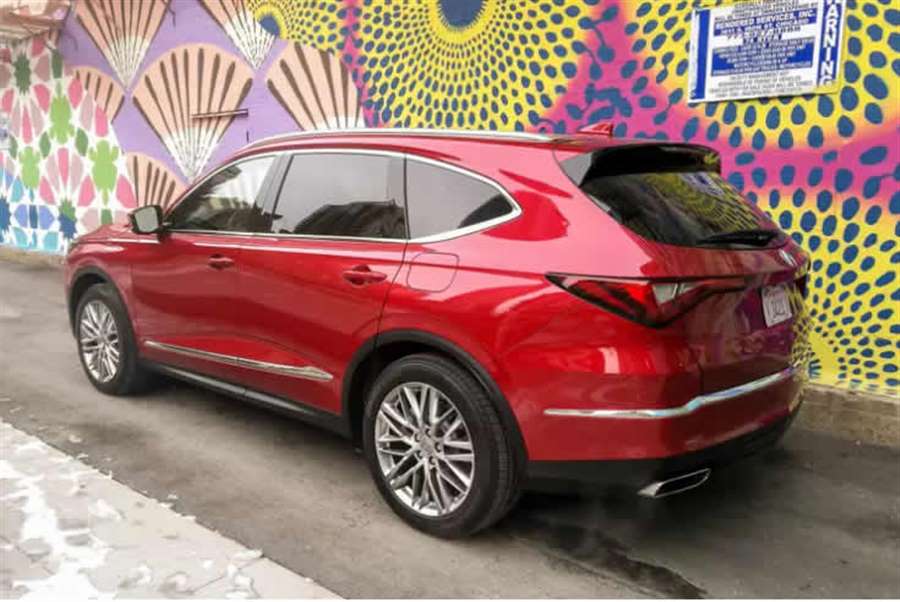
You can click the related link above to read our complete review of the 2022 Acura MDX. Or for a quick recap of this mid-size luxury SUV’s best attributes — plus some items that need a rethink — keep reading below.
Things We Like
1. Smooth V-6, Improved Transmission
Under the hood is a 3.5-liter V-6 that sends 290 horsepower to the front wheels courtesy of a 10-speed automatic transmission; all-wheel drive is optional. This is a smooth and refined powertrain, and the gearbox in particular is a solid step forward from the previous nine-speed automatic. There is no hunting for gears or hesitation in acceleration when powering through city or highway traffic.
2. More Standard and Optional Safety Features
The previous Acura MDX already came standard with an impressive amount of active safety equipment, such as automatic emergency braking, forward collision warning, adaptive cruise control and lane keep assist. Newly standard safety items include a driver attention monitor, pedestrian detection, traffic sign recognition and Acura’s Traffic Jam Assist. This system controls braking and acceleration at slow speed and works to a complete stop, all while maintaining a safe distance behind the vehicle ahead. The aim is to reduce driver fatigue during traffic slowdowns.
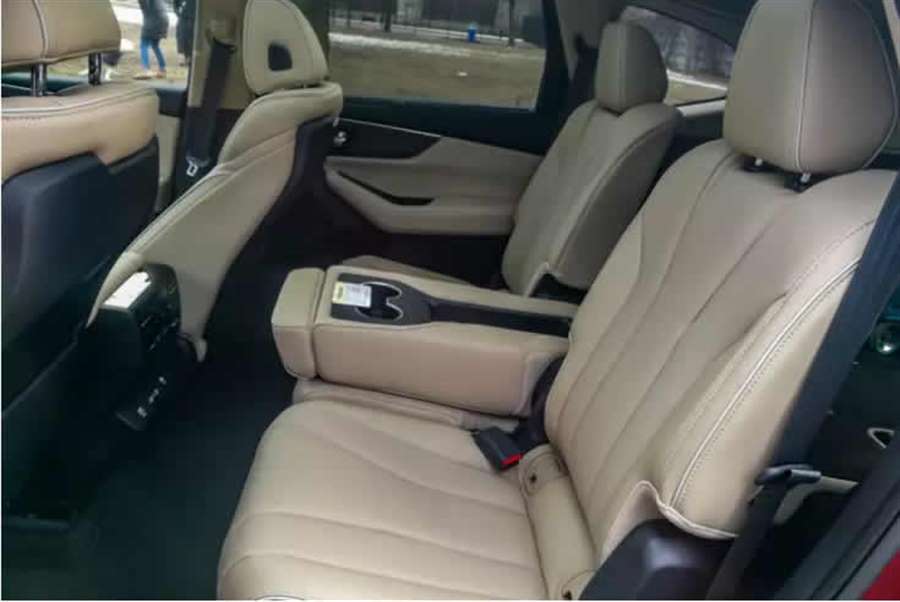
3. Seating Flexibility
The MDX still offers three rows of seating and space for up to seven people onboard. Yet, for the 2022 model year, the second row packs some surprises. The middle seat can be removed to create a nearly 14-inch wide walkway to the third row. This creates more stretch-out space for second-row occupants, and makes it easier to access the third row. Along these same lines, with the push of a button the second-row seats collapse and slide forward to aid anyone climbing into the rear-most seats.
4. Creative Cargo Space
Like the improved seating capabilities, Acura also turned its attention to the MDX’s cargo area. Not only is there more total space behind the third and second row than what rivals offer, the MDX has a few extra cards up its sleeve. There is a roomy underfloor storage compartment as well as a reversible cargo floor with an easy-clean plastic side. Need to haul muddy hiking gear or a particularly dusty antique? Flip the cargo floor and don’t worry about dirtying the trunk’s carpet.
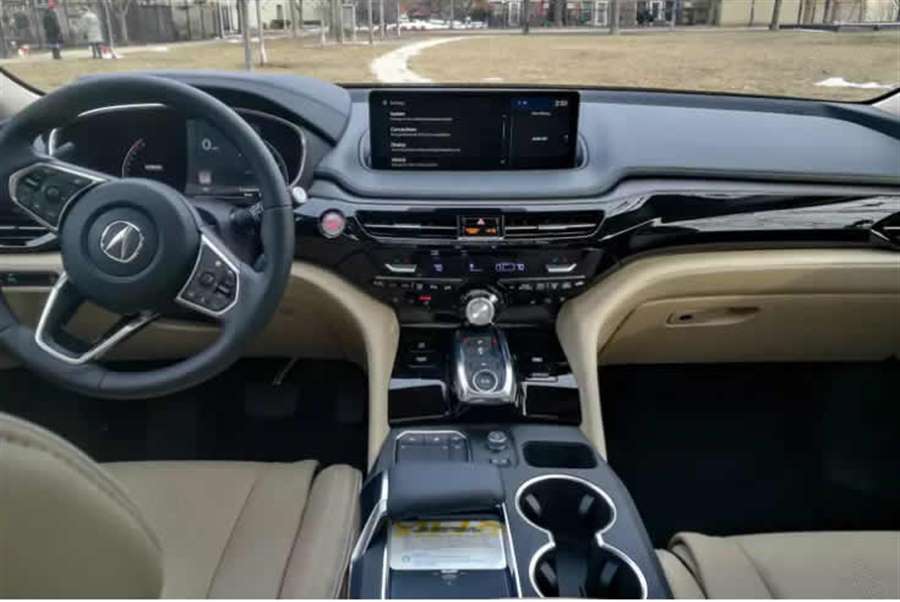
5. Improved Infotainment — to a Point
The good news is that the 2022 Acura MDX has a more intuitive and user-friendly infotainment system than the dual-screen setup used in its predecessor. Wireless Apple CarPlay and Android Auto are now standard, and we found the Amazon Alexa voice controls very handy. The system now comes with a large 12.3-inch screen mounted on the dashboard. While the display is large and clear, things get murky when it’s time to scroll through various menus and controls. More on this in just a moment …
Things We Don’t
1. Fussy Infotainment Controls
While the MDX’s infotainment system is better than before, it still lacks an actual touchscreen. That’s right, the primary means of controlling the system is via a center console touchpad. It takes lots of patience, practice and some luck to get right (especially when you’re driving). The major pieces are all there; Acura is simply short a touchscreen to make everything perform seamlessly.

2. Third Row Remains Best Left for Kids
Getting to the third row is easier for 2022, though the space back there is still best left for kids. Anyone feeling greedy about legroom while perched in the second row will be a serious problem if the MDX is at full capacity. With a second-row seat slid all the way back, there’s not much third-row legroom directly behind it.
3. MPG Is Only OK
The Acura MDX isn’t much better or worse than its mid-size luxury SUV rivals when it comes to mpgs. It’s also not any better than the previous version. In fact, the 2022 Acura MDX is slightly less fuel efficient than the model before it. The difference is small, though it would have been nice to see the new MDX’s overall fuel economy needle move upward, not down.
Mazda MX-30 SUV review
"The Mazda MX-30 is a stylish electric SUV that's fun to drive and affordable"
This is the Mazda MX-30, the first all-electric model in the history of the Japanese manufacturer. It looks stylish, and in keeping with the brand's other models, it's also fun to drive.
Mazda isn't afraid to go its own way, and unlike rival car makers who are locking horns over battery capacity and range figures, the MX-30 instead gets a relatively small, lightweight battery pack. This helps it stay nimble, and Mazda reckons its 124-mile range is also enough to satisfy the driving habits of its target audience, most of whom own another car.
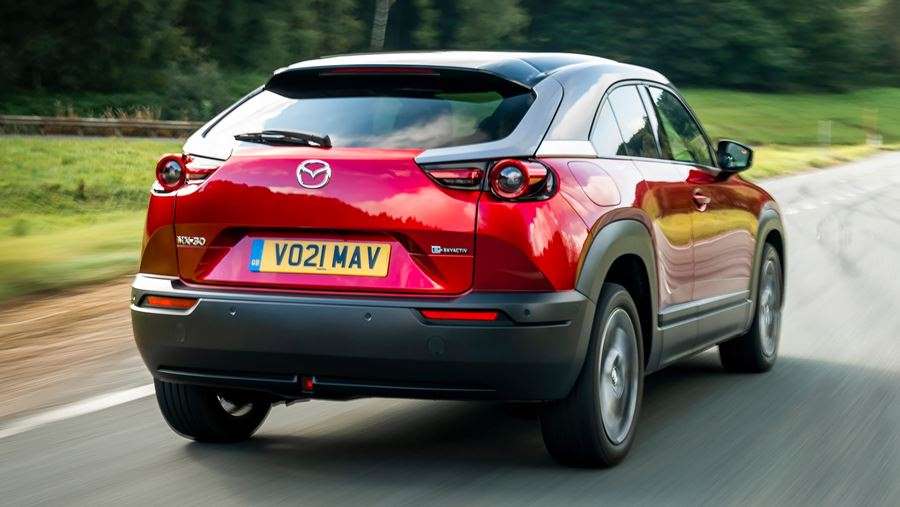
The battery has a 35.5kWh capacity, and Mazda believes using a smaller pack not only boosts handling, but also has less impact on the environment and keeps the MX-30's price down. Speaking of which, the MX-30's list price of around £27,000 (including the government grant and a home charger) is noteworthy, because it means even in the well-equipped First Edition trim it's cheaper than the equivalent higher trim versions of the MG ZS EV and Nissan Leaf.
It can be charged using a home wallbox supply in less than six hours, or topped up from 0-80% in 36 minutes using a 50kW rapid-charger. Handling is certainly a strong point; the MX-30 can flit between corners without fuss and Mazda's well-weighted steering and feelsome brakes have also made the transition from combustion to electric power intact, but with 143bhp, performance is fairly modest for an EV. Acceleration from 0-62mph takes 9.7 seconds, compared with 8.5 seconds for the MG ZS EV, and the MINI Electric feels much quicker off the mark.
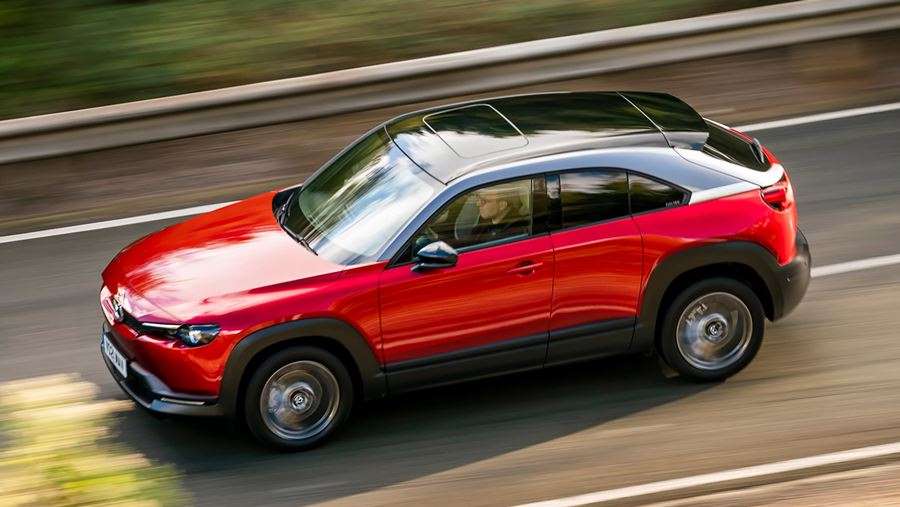
Looking like nothing else with a Mazda badge, the MX-30 features rear-opening back doors, hindering practicality somewhat. There are five sets of seatbelts but getting in and out of the rear is slightly awkward, and the back windows cannot be lowered, making it claustrophobic for rear passengers. Life is far better in the front, thanks to comfortable seats with a vegan-friendly leatherette upholstery, cork trim inserts and door trims using recycled plastic bottles. Mazda has been making some great interiors in recent years, and this is no exception.
The first 500 UK cars were all First Edition models, which came with a strong kit list including a heads-up display, sat nav and digital instruments. The standard model range comprises SE-L Lux, Sport Lux and GT Sport Tech, all of which are well equipped.
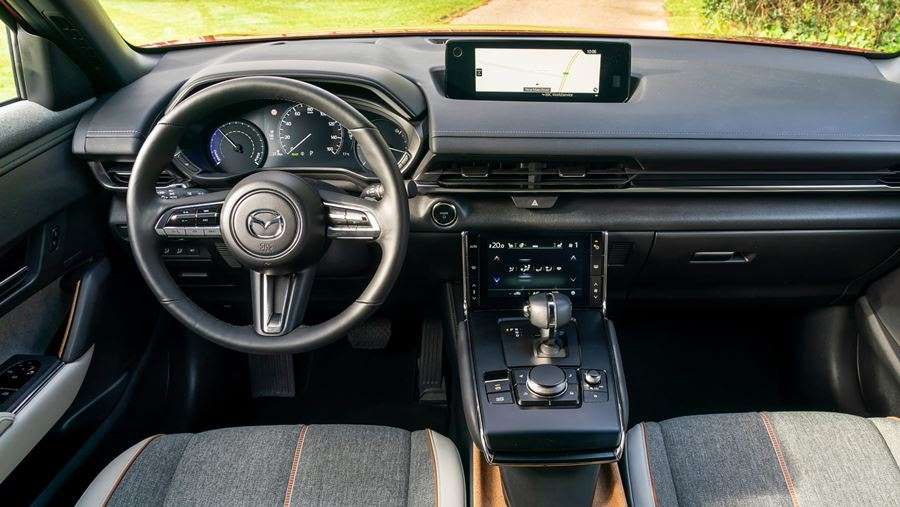
The Mazda MX-30 also bagged a five-star safety rating from Euro NCAP in 2020, with impressive crash-test results across the board. Plenty of smiles from behind the wheel, an attractive interior and low running costs will impress buyers, but they'll need to only carry rear passengers very occasionally and be happy with the car’s limited range.
MPG, running costs & CO2
Forget range anxiety and Mazda's decision to offer a smaller battery pack makes sense
As with its SkyActive petrol and diesel engines, Mazda is looking to buck common trends with its first EV. Instead of engaging in a race to fit the biggest battery pack possible, the MX-30 instead has just a 35.5kWh capacity, giving it up to 124-miles range between charges. While such a short range is easier to forgive for city cars like the MINI Electric and Honda e, it's harder to justify for a bigger one. Most rivals such as the Tesla Model Y and Volkswagen ID.4 will easily double this.
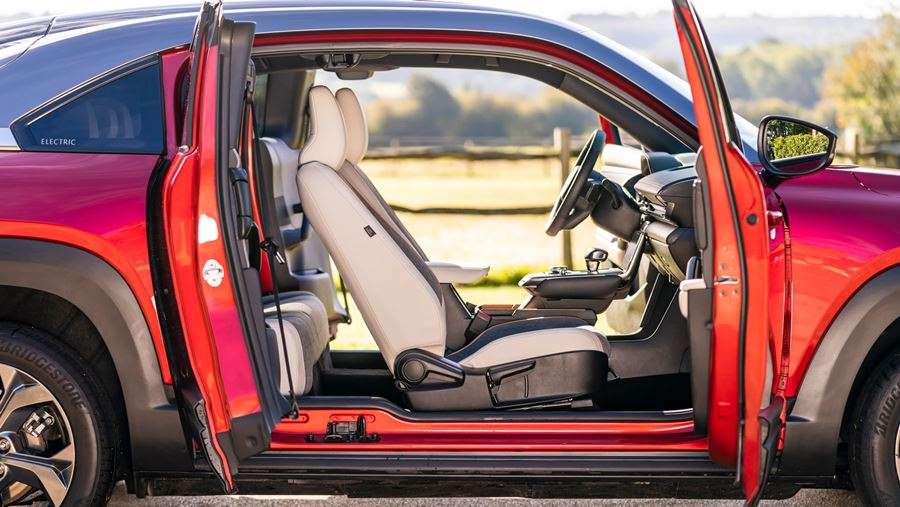
Mazda's thinking is that production of larger battery packs is bad for the environment, and that they're heavy, negatively affecting how the car drives. Mazda also points to research that 95% of the MX-30's target buyers drive less than 60 miles a day. They're the sort of drivers who are likely to tackle the school run, commute to work and drive locally to shop or see friends, rather than regularly travel long distances on the motorway. It's also likely they'll plug the car in overnight at home whenever it's necessary, and a free home charger comes as part of the deal.
A full charge takes less than six hours using a 7.4kWh wallbox, but it's also possible to charge the MX-30 at up to 50kW using a public rapid-charger and its CCS connection. Do so and the battery can be topped up from 0 to 80% in 36 minutes. The range-topping Volkswagen ID.3 offers up to 125kW rapid charging. VED (tax) is currently free for electric cars, which also enjoy the lowest rates for company-car drivers and free entry into low emissions zones like the one covering central London. There's also a major advantage for company-car drivers, thanks to low Benefit-in-Kind (BiK) liability, reducing monthly bills.
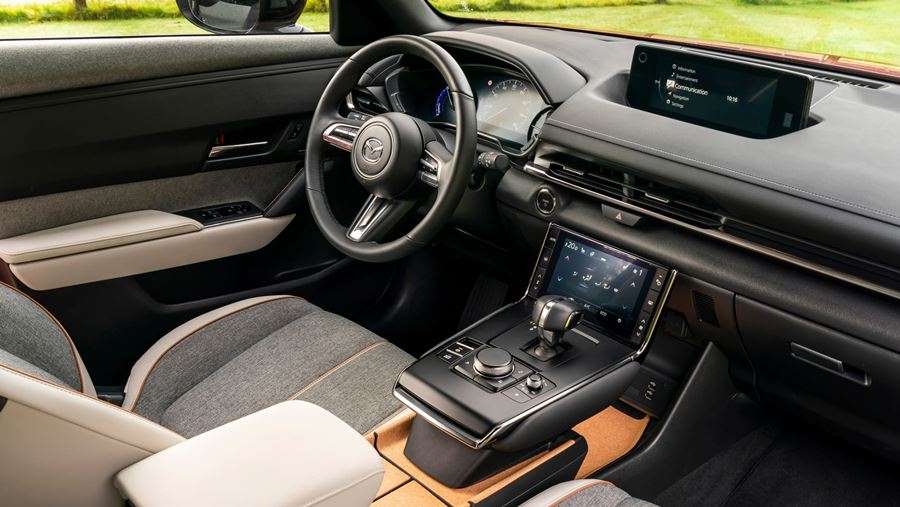
Engines, drive & performance
It doesn't have screaming acceleration, but the Mazda MX-30 is a satisfying steer
The 'MX' badge is usually reserved for Mazda's sporty models, such as the iconic MX-5 roadster, so is it deserved here? Weighing around 1,600kg, the MX-30 is certainly light compared with other electric SUVs, and this pays dividends in almost every driving situation. There's never any feeling of dragging the MX-30 around corners, instead, it's agile and quick to respond, with very little body lean. In fact, we found its handling finesse makes it almost as fun to drive as the smaller MINI Electric, even if it doesn't have as much punch when you hit the throttle. Its steering is precise and requires just the right amount of effort.
Mazda MX-30 SUV front cornering20he brakes feel natural too - not always a given in alternative fuel cars that harvest energy from braking regeneration. The strength of the electric motor's braking effect can be adjusted on the move via the paddles mounted on the steering wheel. Even in its strongest mode it doesn't quite allow for one-pedal driving, but you can learn to use it to slow the car in predictable traffic - only using the brakes for unexpected stops.
Just don't expect acceleration worthy of 'reaction videos' on YouTube as your friends are pinned back in their seats, Tesla-style. With 143bhp, the MX-30's electric motor feels more on a par with diesel rivals for acceleration, taking 9.7 seconds to get from 0-62mph. Top speed is limited to 87mph. Of course, with just one forward gear and no turbo lag, there is the benefit of smooth progress as soon as you press the throttle. You'll also notice a synthetic engine sound to help make the MX-30 feel natural for drivers.
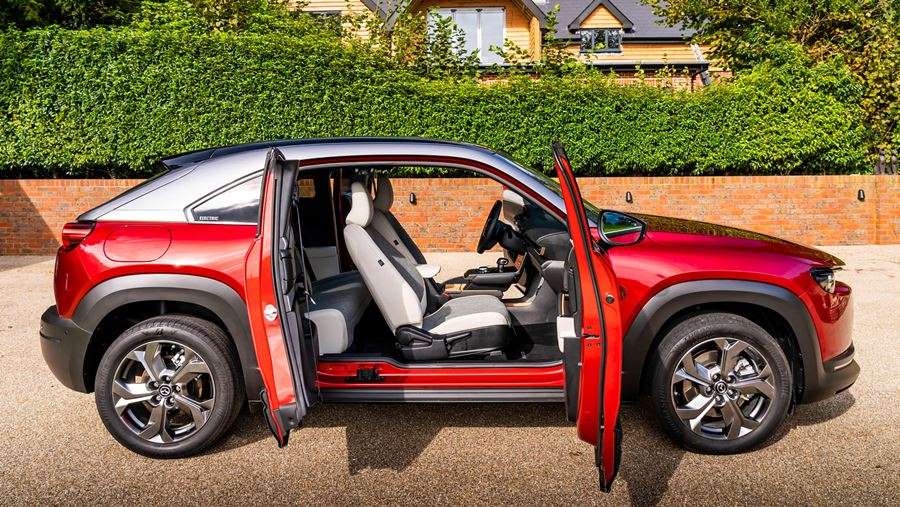
Interior & comfort
Mazda has incorporated renewable materials without any loss of quality
Mazda has long been known for its striking designs, and the CX-30 is no exception. Its interior follows the brand's recent uptick in quality adding some striking materials and features into the mix. The centre console trays and door handles are lined with cork from the bark of trees that have fallen naturally, while the door trim incorporates fibres from recycled plastic bottles. The only disappointment is some cheap plastic around the gear selector.
Its suspension is supple enough to ensure the MX-30 feels planted but doesn't bounce or skip uncomfortably around corners, so passengers should be comfortable. However, the driver will likely wish the rear windows weren't quite so sloping and dark, as they restrict over-the-shoulder visibility when manoeuvring. The mixture of touchscreen and rotary knobs for the ventilation controls also takes some getting used to.
Standard equipment is generous, including a head-up display, seven-inch digital instruments cluster, sat-nav and a rear-view camera. The First Edition trim level was available to the first 500 buyers and its design elements included 18-inch alloy wheels and light upholstery with grey cloth, stone leatherette and orange stitching. Two solid paint colours are available for free, or buyers can upgrade to a three-tone hue for around £1,000.
Following on from the First Edition, there's SE-L Lux, Sport Lux and GT Sport Tech trims. Sport Lux gets 18-inch alloy wheels, heated front seats with lumbar adjustment and keyless entry, along with the option of 'three-tone' contrasting paintwork. The GT Sport Tech range-topper features a sunroof, heated steering wheel, 12-speaker Bose stereo and front wiper de-icer, along with the option of artificial leather upholstery.
Practicality & boot space
Its rear-opening doors look cool, but hamper practicality somewhat
In a nod to the Mazda RX-8 sports coupe, the MX-30 features a set of rear-opening back doors. It’s an intriguing design, but there are compromises when it comes to functionality. For a start, they aren't as big as most rivals' back doors, and it's necessary to fold the front seat out of the way to get inside. It's also rather claustrophobic in the back of the MX-30, made worse by the fact the rearmost windows cannot be opened and a lack of kneeroom. Longer trips will be hampered by low and shallow seat bases that don't provide much thigh support to taller passengers but headroom is adequate.
The MX-30 has a sloping rear profile and stubby tail, with almost no overhang behind the rear wheels, so boot space isn't much better than in a supermini. There's up to 366 litres behind the rear seats but this reduces to 341 litres in the range-topping GT Sport Tech version.
It's possible to split and fold the 60:40 rear seats, but there aren't many clever features like an adaptable boot floor or hidden compartments, and space extends to 1,171 litres. With the engine bay taken up by the electric motor, there's also no 'frunk' like you'll find in some larger EVs. It's also likely the electric Mazda will follow the path of other small EV's and be deemed unsuitable for towing.
Reliability & safety
Owner satisfaction and safety are both strong areas for Mazda
Mazda has an excellent reputation amongst owners, who voted the Japanese brand into fourth place in our 2020 Driver Power satisfaction survey. They are impressed across the board, and find the interiors well screwed together, while running costs are also low. However, practicality was one area where improvement was deemed necessary, with more child-friendly features and flexible seating common requests.
Being an all-new model, there's no data yet on how the MX-30 will fare, but given Mazda's typical attention to detail and its new EV powertrain, we'd be surprised if it wasn't one of its most reliable models yet.
The MX-30 is certainly fitted with the latest safety tech, from autonomous emergency braking and lane-keeping, to a system that monitors the driver's attention levels. In the event of an accident, e-Call with GPS can also inform the emergency services and provide them the vehicle's exact location.
It all helped the MX-30 achieve a five-star safety rating from Euro NCAP, with impressive scores of 91% and 87% in the adult and child occupant protection categories respectively.
Ford Puma review
The Ford Puma is back - the small, sporty coupe is now a stylish, practical compact SUV that’s good to drive, but lacks cabin space.
We’ve waited a while for Ford to give us a proper compact SUV based on the Fiesta. Until now, the firm’s sole offering in the B-SUV market - the EcoSport - has not been good enough. The new Ford Puma hits the right notes and is precisely what you’d expect of the brand, blending practicality and affordability into a package that’s good to drive.
The Puma’s looks won’t appeal to everyone, but few rivals can better it for boot-space and virtually none can outshine the Puma from behind the wheel - equipment levels are strong too. However, there are more upmarket-feeling and spacious rivals out there for this sort of cash.
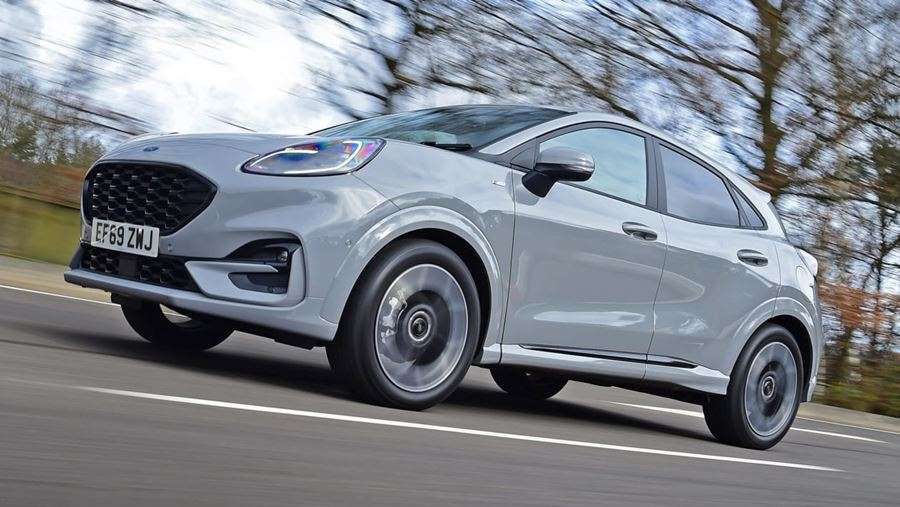
About the Ford Puma
Cast your memory back to 1997, and you may remember Ford launched a fun, small, front-wheel-drive coupe based on what was then the fourth-generation Fiesta. It added a bit of richly needed desirability at the smaller end of the brand’s British line-up. It was a hit - the Ford Puma had landed.
Now, the Puma name is back, and it’s an extremely similar story save for one very important detail; the new Ford Puma is not a small coupe, but a small five-door SUV. It’s based on the current, seventh-generation Fiesta supermini, sharing its chassis and its engines, as it enters a market that’s overflowing with choice at the minute.
Chief rivals include the Renault Captur, the Peugeot 2008, Skoda Kamiq and SEAT Arona, while the handsome Mazda CX-3 and spacious Volkswagen T-Cross offer further possibilities for customers considering a small family SUV. Left-field alternatives include cars like the design-led Nissan Juke, chunky Jeep Renegade and the retro Fiat 500 X.

The Puma line-up isn’t quite as expansive as the Fiesta’s, but there are still plenty of models to choose from and even more engine options will be available soon. The trim structure is very straightforward too, with four core versions: Titanium, ST-Line, ST-Line X and luxury ST-Line Vignale. The Puma ST performance model sits at the top of the range.
The Titanium is the entry-level trim for the Puma range, but it’s still well equipped and finished with flair, including 17-inch alloy wheels, a leather steering wheel, power folding mirrors, navigation via an eight-inch central touchscreen display, cruise control, rear parking sensors and even a wireless charging pad. The other side to this is that the Puma’s starting price is relatively high compared with rivals, many of which start from below £20,000.
ST-Line models add a bit more standard equipment such as a widescreen 12.3-inch digital instrument display and automatic headlamps. But these cars major on sporty touches including a body-kit, different alloy wheels, sports seats and pedals and a sports suspension setup that helps the Puma to shine as one of the best crossovers to drive.
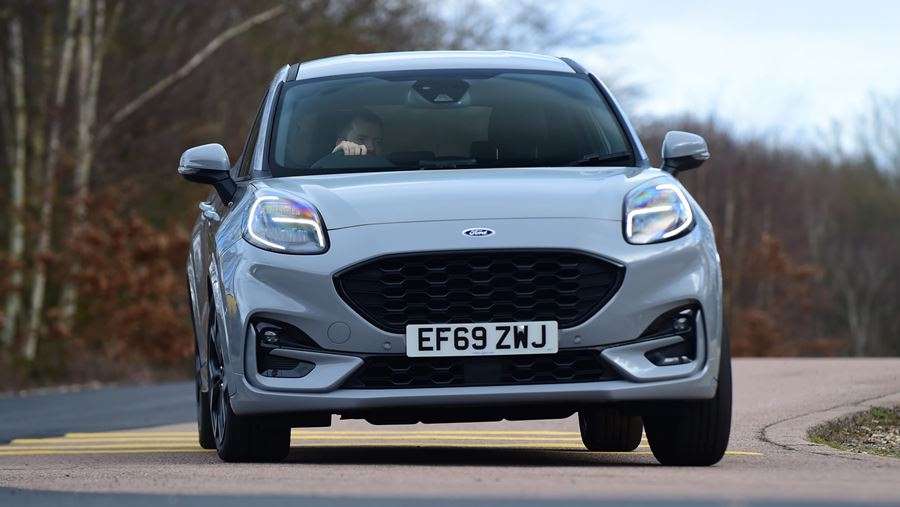
ST-Line X builds on this with luxury features such as partial leather upholstery, privacy glass in the windows and a 10-speaker audio setup from Bang & Olufsen, while the Vignale upgrade brings heated front seats, front parking sensors, keyless entry and Windsor premium leather upholstery.
The Puma is front-wheel-drive only and buyers are offered three engine options. The EcoBoost 125 uses a 123bhp 1.0-litre turbocharged three-cylinder engine as found in the Fiesta, while a 48-volt mild-hybrid version of this engine is also available. It doesn’t bring any additional power, although there is a slight increase in torque, and it introduces marginal reductions in CO2 emissions and gains in fuel economy, too. The third option is another 1.0-litre three-cylinder turbocharged petrol with the same mild-hybrid system, but power is pushed up to 153bhp.
Mild-hybrid versions of the Puma use a six-speed manual gearbox for now, with a seven-speed automatic available with the 123bhp non-hybrid variant, although Ford has plans to introduce the auto transmission throughout the Puma range.
For the performance enthusiast, the Puma ST is arguably the best-handling compact SUV on sale, powered by the Fiesta ST’s 1.5-litre engine for a total of 197bhp.

Ford Puma review - Engines, performance and drive
The Puma’s proven 1.0-litre EcoBoost units are a known quantity, but the mild-hybrid system isn’t flawless.
Ford’s reputation for fun family cars has been sealed with models like the Focus and Fiesta, while the original Puma - though short lived - is another prime example of the Blue Oval’s proficiency in chassis development.
Much the same can be said of this Puma, thanks in the main to the Fiesta chassis that sits beneath it. It links up with a solid 1.0-litre EcoBoost engine to deliver a family crossover that’s good to drive.
When we pitted the Puma up against the Renault Captur and Peugeot 2008, we hailed the Ford as being “easily the best to drive.” The driving position is fundamentally sound, and once you’re settled in, you’ll quickly see why the Puma has won plaudits.
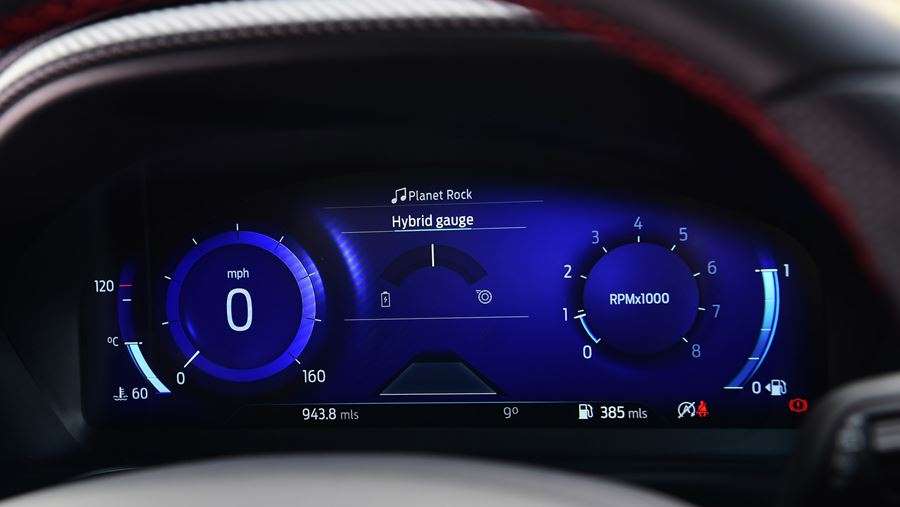
Get on the move and the steering feels light - even if you put the Puma into the Sport mode using the drive mode selector. But, it’s well resolved for a car like this, accurate, keen to re-centre and with a great steering ratio. There’s a good level of grip too, so immediately the Puma feels like a crossover that you can flick through corners nicely. The six-speed gearbox is lovely, too, while Ford’s engineers have also done a good job with the Puma’s suspension.
Even with the sports suspension on the ST-Line model, the damping is very well set up and it has a decent level of compliance. It all comes together to mean that the Puma has brilliant composure and the ability to offer an engaging drive.
The Puma ST is based on the sublime Fiesta ST hot hatchback, which means a 1.5-litre three-cylinder turbocharged engine under the bonnet, making the same 197bhp and 320Nm of torque.
Engines, 0-60 acceleration and top speed
All three engines are based on the same 1.0-litre engine block, but there’s quite a difference between them, owing to the Puma’s various drivetrain technologies and power outputs.
The 1.0-litre EcoBoost engine has been a really strong contender in its various applications over the last few years, and the Puma is another vehicle where this small engine shines. It may no longer be the outright best three-cylinder engine on the market and some engines - such as the TSI units used in the Volkswagen Group cars - may be more refined these days, but you shouldn’t be disappointed.
The 123bhp and 170Nm torque served up by the base model is enough for most family motoring, propelling the Puma to 62mph in 10.0 seconds and on to a top speed of 119mph.
Hybrid badge
What is a hybrid car? Mild hybrids, full hybrids and plug-in hybrids explained
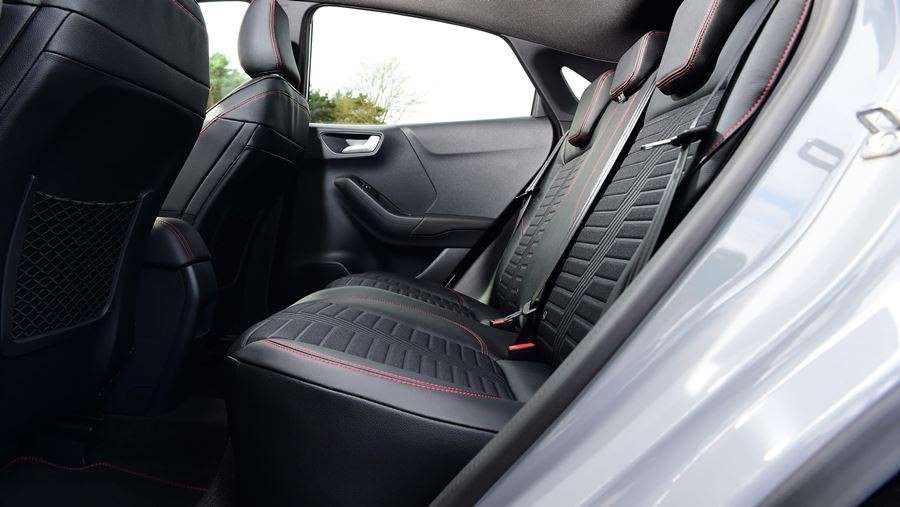
Pick the mild-hybrid version and the power stays at 123bhp, but torque improves to 210Nm thanks to the small amount of electrical assistance. Top speed is still 119mph, but the 0-62mph time falls a little to 9.8 seconds. The real benefit is lower CO2 emissions from the exhaust pipe and better running costs from improved fuel economy, which we’ll come to on the next page.
The only downside to the mild-hybrid system is that to fill the small battery pack with energy, the Puma features a very minor amount of brake energy regeneration. It’s set at a constant, unchangeable level, that’s just about detectable when you lift off the throttle and feel the car slow more quickly than it otherwise would, and takes a little getting used to.
If you need more power, the 153bhp car has you covered. It also has braking recuperation that cannot be altered in strength, but it takes 8.9 seconds to reach 62mph from standstill and goes on to a top speed of 124mph.
The 197bhp ST performance model dispatches the same sprint in 6.7 seconds, with a 137mph maximum.
Ford Puma review - MPG, CO2 and running costs
Ford uses proven 1.0-litre petrol engines for the Puma, with mild-hybrid technology helping to improve economy and emissions.
Ford’s 1.0-litre three-cylinder EcoBoost unit has received much praise for its versatility and ability to blend decent power with good returns from a tank of fuel. So, it’s probably no great surprise that the engine is at the core of the Puma range.
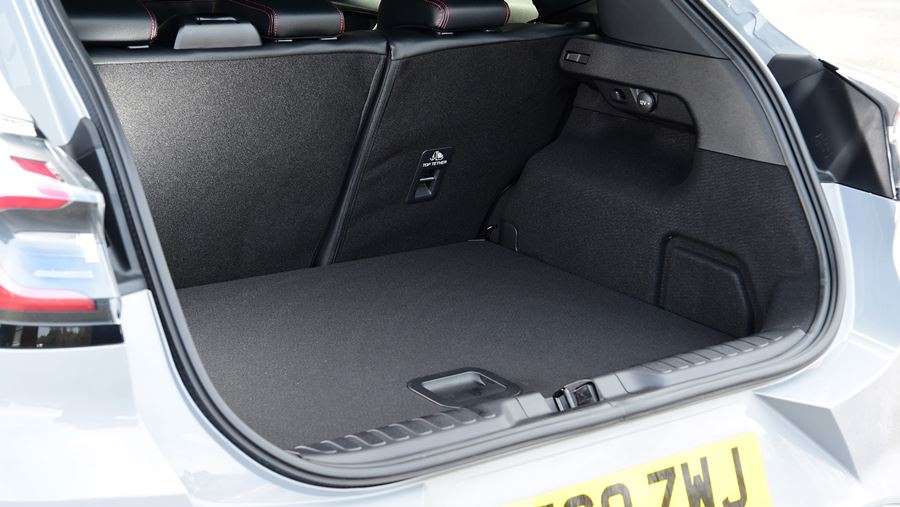
The flexible 1.0-litre powerplant comes in three guises for Puma customers. The base 123bhp version returns a maximum 46.3mpg, with 138g/km of CO2, while the same unit with 48-volt mild-hybrid assistance is able to improve on these figures a little by delivering a claimed 50.4mpg and CO2 levels of 127g/km.
The 153bhp variant produces the same economy and CO2 figures as its lower-powered sibling, while the 197bhp Puma ST still performs pretty well with 41.5mpg on the combined cycle and 155g/km of CO2.
Most economical SUVs, 4x4s and crossovers 2021
The mild-hybrid system captures kinetic energy naturally lost while driving, particularly during braking, before storing it as electricity in a small battery. This electrical energy is then used to assist the engine during acceleration, reducing the amount of petrol needed to make decent progress.
Drivers can view a display on the digital instrument panel to see exactly when the system is in action. Alongside it, cylinder deactivation means the engine can run on two cylinders where driving conditions allow, to save more fuel.
Insurance groups
Insurance premiums for the Puma range should be competitive with those of rivals. The base 123bhp Titanium model comes in at group 11, while the ST-Line Vignale cars with 153bhp occupy group 15. The 197bhp ST variant is in group 22.
Competitors such as the Renault Captur start at group 8 for an entry-level 99bhp version and move through to group 21 for a top-of-the range model with 152bhp.
Depreciation
Our experts predict the Ford Puma will retain a healthy 51% of its original value over 3 years and 36,000 miles, whereas the Renault Captur keeps an average of 43% over the same period.
Ford Puma review - Interior, design and technology
The Ford Puma has a familiar cabin design and good levels of standard kit, but overall quality can’t match rivals.
Ford’s new small SUV is based on the best-selling Fiesta, which is no bad thing. Despite being one of the smaller B-segment models, the Puma has ensured it stands out from competitors with a distinctive design and impressive levels of standard equipment.
In the cabin, the dash and centre console will be familiar to those who’ve peered inside a recent Focus or Fiesta, although the visible plastics aren’t the Puma’s greatest quality. There’s far too much hard black stuff to be found, while other small SUVs are available with nicer interiors, and for similar money.
Ford offers four individual trim levels for the Puma. The entry-level Titanium is still very well equipped with 17-inch alloy wheels, LED rear lights and daytime running lights, body-coloured exterior trim, power-folding heated mirrors, rear parking sensors and selectable drive modes.
ST-Line models include a muscular body-kit, sports suspension, a leather sports steering wheel and alloy pedals, although the ST-Line X car adds stylish 18-inch wheels, partial leather seat trim, privacy glass and carbon-effect interior accents.
The luxury Vignale version ups the luxury count with heated seats, Windsor premium leather upholstery, a heated steering wheel, front parking sensors and keyless entry, while the ST car features 19-inch alloy wheels and a body styling kit.
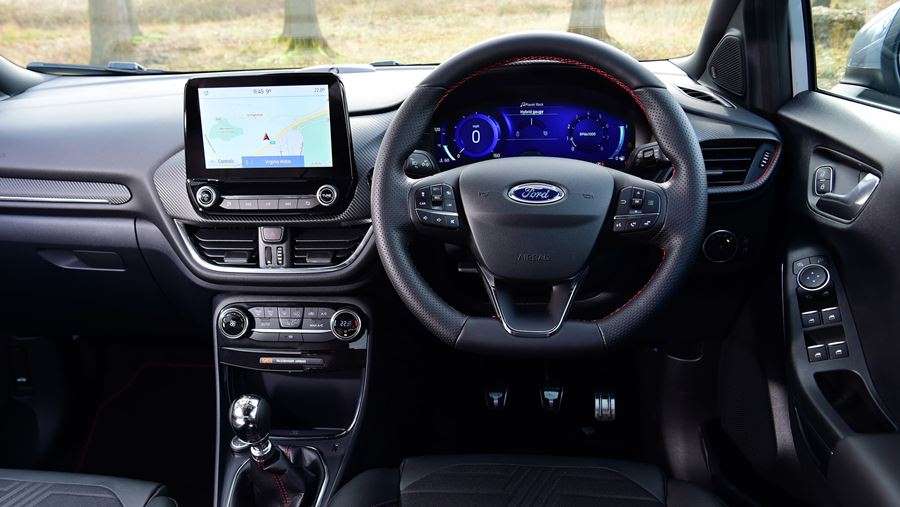
Sat-nav, stereo and infotainment
All Puma models come with Ford’s SYNC 3 infotainment system, including navigation, Bluetooth, a DAB radio and Apple CarPlay and Android Auto functionality. There’s also a wireless charging pad as standard. Bearing in mind the high list prices as you climb the range, the Titanium trim offers a sweet spot in terms of equipment and on-board tech.
ST-Line cars feature a 12.3-inch digital instrument display which, along with the central touchscreen, is sharp and easy to navigate. And, if you feel the need for better quality audio while on the move, the ST-Line X models add a B&O Premium stereo with 10 speakers.
Ford Puma review - Practicality, comfort and boot space
Although smaller than most rivals, the Ford Puma remains practical for family use and offers clever storage solutions.
Ford has worked hard to ensure the compact Puma combines its athletic low stance with plenty of practicality and comfort. From the driver’s seat, the links to the Fiesta’s chassis are clear, with ability to tackle the twisty stuff with vigour as well as being a solid, quiet performer at motorway speeds.
ST-Line cars get sports suspension, and while on the firmer end of the spectrum for SUVs of this size, it’s not overly harsh. The driving position definitely feels sportier while there’s a great level of adjustment in the seat and steering wheel, a typical Ford trait.
Size
The Puma is one of the smaller options in the supermini sized SUV class. It measures 4,207mm in length, 1,805mm wide and stands 1,537 tall. By comparison, the Peugeot 2008 and Mazda CX-3 are 93mm and 68mm longer, respectively.
Leg room, head room & passenger space
The Puma manages to maintain decent passenger space, despite its sloping roofline. Room up front is very good, while the rear bench is an acceptable size.
Passenger space in the rear is compromised when compared with a Renault Captur. Passengers in the back sit higher up, which brings your legs back towards the seat base, so although there’s enough space overall, the seating position might not be as comfortable.
Boot
A boot of 456 litres is on-par with competitors in this class, and there’s virtually no lip to get over, so awkward items shouldn’t be too tricky to load. In comparison, the Peugeot 2008 offers 434 litres of boot space and the Renault Captur 12 litres less than that, although the Captur has an ace up its sleeve in the form of a sliding rear bench seat. When the bench is pushed all the way forward it frees up a 536-litre capacity.
One area where Ford has been rather clever is in the Puma‘s adjustable boot floor with the so-called ‘Megabox’ hidden storage area beneath. This is a 68-litre plastic compartment that you can use to store muddy boots or wet clothes, for example. It also has a drain plug so you can hose it out. Plus, Ford claims that using the MegaBox allows you to stand a golf bag upright in the Puma’s boot.
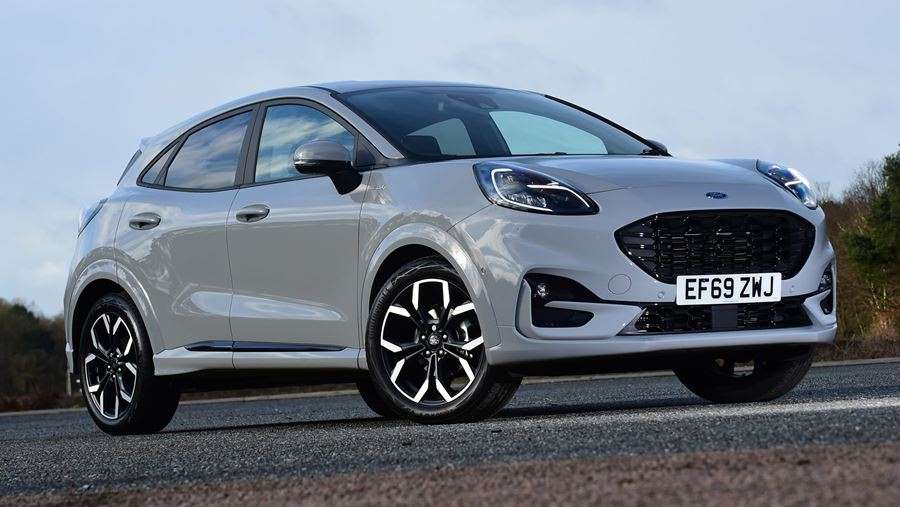
Ford Puma review - Reliability and safety
Ford has a lot riding on the success of the Puma. It’s previous effort at a small SUV, the EcoSport, was a poor one, so the brand has to get this right. Fortunately, the Puma arrives with proven engines, a chassis based on the best-selling Fiesta and interior tech already in use across other model ranges. We’d expect the Puma to be a car you can rely on, and also one that keeps the driver, passengers and other road users as safe as possible.
All models include cruise control, a lane keeping aid with departure warning, Pre-Collision Assist with Autonomous Emergency Braking, Pedestrian/Cyclist Detection and Post-Collision Braking. Other useful features include auto headlights, rain-sensing wipers and a tyre pressure monitoring system.
Those wishing to upgrade further can opt for the Driver Assistance pack (£900), which adds a blind spot warning, adaptive cruise control and a rear view camera among other features.
The Puma was tested by Euro NCAP in 2019 and achieved a full five-star rating. Adult and child protection was rated at 94% and 84%, respectively, while the car scored 77% for pedestrian safety.
Although Ford finished a disappointing 24th out of 30 manufacturers in our 2020 Driver Power customer satisfaction survey, it’ll be looking towards cars like the new Puma to guide it to improved results next time.
Warranty
Every new Ford car comes with a 3-year/60,000 mile warranty. There’s also the benefit of Ford Assistance for 1 year, providing roadside cover in the UK and throughout Europe.
If you plan on keeping your car for longer than three years or are a high mileage driver, you can extend the standard warranty to either 4 years/80,000 miles or 5 years/100,000 miles.
Servicing
Ford offers the Ford Protect Service Plan giving you the option of scheduled services and extended Ford Assistance. It covers scheduled servicing including associated parts and labour, and vehicle hire for up to 7 days. The Ford Protect Service Plan can be purchased any time before the first service is due.
New Toyota 4Runner Coming in 2023? Find Out Here!
Apart from being the fan-favorite Toyota model in the lineup and being one of the last North American models still assembled in Japan, the Toyota 4Runner is consistent. In fact we’ve often referred to this iconic off-roader as the king of consistency. For the better part of 11 years, the fifth model generation has been available at dealerships and commanding trails. While we at Toyota of Clermont are thoroughly enamored by the current model year, even we have to admit that change is long overdue for 4Runner. Whether it be now or later, a large-scale overhaul is due for the popular Toyota SUV and we’ve seen some rumors that seemingly confirm this.
If you want to know more, read along with us at Toyota of Clermont!
What Might Be in Store for a New Toyota 4Runner
The Toyota 4Runner has been in its 5th generation since 2009 and many drivers are clamoring for a change to the body-on-frame SUV. While Toyota has not confirmed anything regarding a new generation 4Runner and what features it might have, many fans have been speculating a laundry list of changes they want to see happen.
Engineering
Toyota is rumored to be making large-scale changes to the engineering features in many Clermont models. Larger models like the Tundra and Toyota 4Runner have largely remained untouched but that could all change soon. After all, Toyota has vowed to offer some form of electrification in its vehicles in the near future. For the 4Runner, this could mean the introduction of a hybrid drivetrain. This could vastly improve the fuel efficiency of this meaty Clermont Toyota SUV and add a bit of extra speed to its wheel house.
There’s also an idea floating around that there could be several engine options available on the next generation Toyota 4Runner. Many fans favor the current 4.0-liter V6, but adding larger and smaller options could reduce the overall cost and prime the Clermont 4Runner for wider appeal. It’s also possible that Toyota could integrate a turbocharger or other options in a new generation.
Exterior
As with all generational shifts there’s a dramatic exterior design overhaul. We expect nothing less for the Clermont Toyota 4Runner. But, what would that look like? More than likely, Toyota will retain the high-profile and muscular design of the current 4Runner. However, the front grille is likely to change along with the rear-end, and sides. Due to the popularity of enhanced special editions for this generation, the next generation 4Runner might include accessories like roof baskets, tow kits, and other off-roading gear standard.
Interior
Again, new generations mean large-scale changes to just about everything. The interior of the current generation Toyota 4Runner has received its fair share of complaints. For a new generation of this Clermont Toyota SUV you can likely expect to see new infotainment options, a wider array of upholstery materials to choose from, better stylistic elements, and better space distribution.
One thing’s for sure, the power rear-window needs to stay!
Shop for a Toyota 4Runner with Toyota of Clermont Today
While it’ll be some time before the next generation Toyota 4Runner heads our way, you can still experience the Toyota 4Runner today at Toyota of Clermont! Shop our inventory online anytime and visit the dealership at 16851 State Road 50 for a test drive.
Posted in New Toyota
New Mitsubishi Outlander PHEV review: the popular hybrid driven
The Mitsubishi Outlander is very much on trend. It's an SUV, and also a plug-in hybrid – but it actually arrived slightly ahead of its time. Here we're driving the current model, which is almost identical to the previous car aside from the lightest of facelifts and a few technological tweaks aimed at keeping ahead of emissions regulations. Why mess with success? It's an established big seller in Britain, although the rest of the range hasn't been doing so well, prompting plans for Mitsubishi to leave Europe. For now, though, this Outlander is a current model, available through the familiar dealer network. The question is, in a market that's now brimming with hybrid SUVs, does the
How can I spot a new Mitsubishi Outlander?
With difficulty. Mitsubishi’s goals for this version clearly didn’t include major styling changes. In fact, even sat next to a 2018-spec car, it takes a few moments to spot the newer LED headlights and the lightly tweaked front grille and bumpers. The new design for the wheels is the biggest giveaway.
Inside, there’s a tweaked instrument cluster, plus new air vents and a USB port for rear passengers.
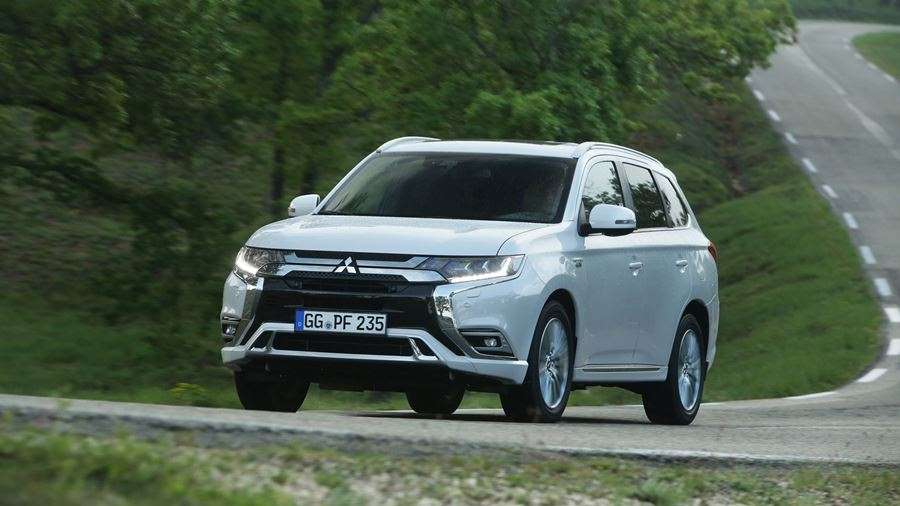
The sunroof has been relegated to the options list in an attempt to fend off the extra car tax premium buyers have to pay when pricing creeps above £40,000.
While we were impressed by the quilted leather upholstery on the seats of our test car, these are limited to the top-spec models costing north of £40k.
Still, the range starts at below £36k for the Verve, and the big-selling Dynamic version still comes in below £40k, and includes heated leather seats and a lot of safety and convenience equipment.
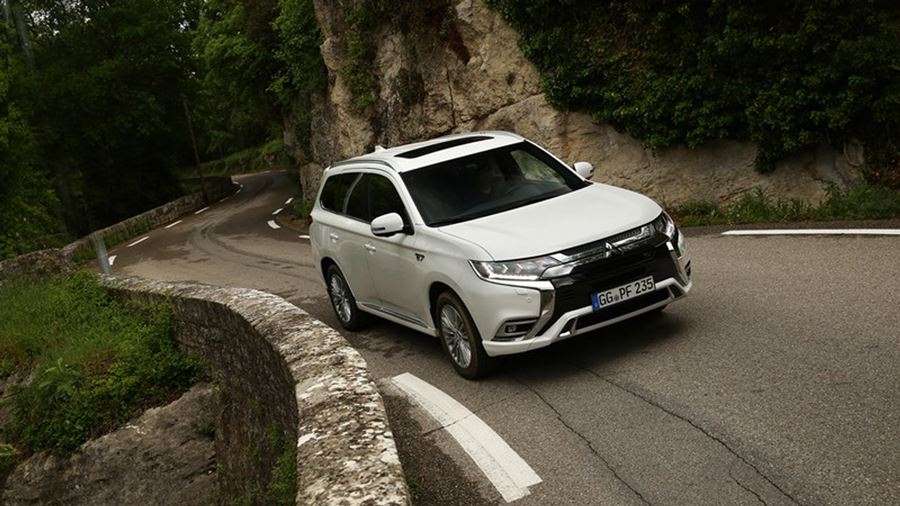
What’s the Mitsubishi Outlander hybrid like to drive?
It’s not that far removed from the previous generation, which we drove back-to-back with this latest verion, but in a couple of important respects improvements have been made. The first is in cabin refinement, because the current car is quieter, rides better and feels more solid than ever.
There’s been extra adhesive applied to the body-in-white (before painting) to strengthen the shell using an approach similar to that used in aircraft manufacture, and this has the effect of enhancing torsional rigidity, so the car flexes less through bumps and bends. The difference is slight, but worthwhile.
The tyres have changed from Toyo to Yokohama, there’s a quicker steering rack and the suspension has been recalibrated.
Doesn't sound like much of a big deal? But in fact the handling and body control have improved. The quicker steering is the most notable change, making this Outlander easier to thread through narrow roads. Road-noise intrusion levels have turned down a notch too.
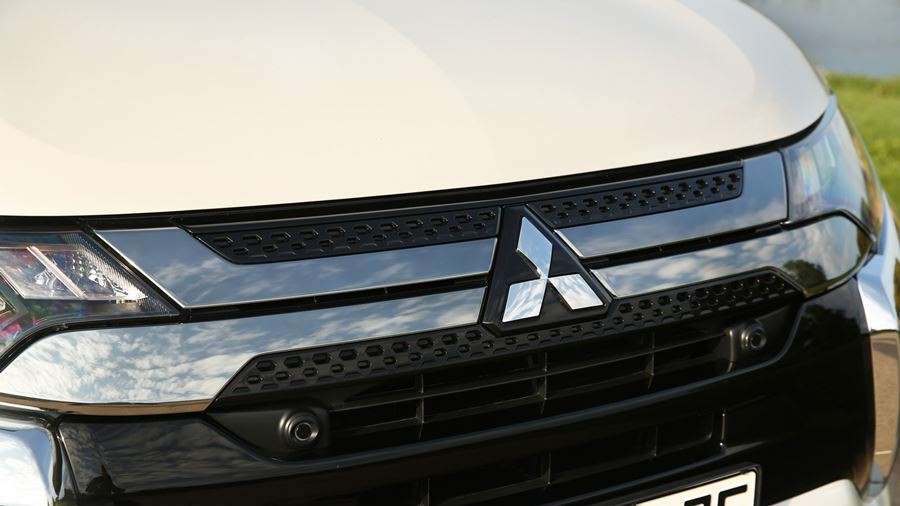
What has been sacrificed is the ride quality, which has become a bit busy on UK roads. It’s not uncomfortable by any stretch, but it feels far less settled than before. A fair trade-off for a bit more verve? Almost.
There’s a new Sport mode that offers a bit more punch, but this feels incongruous in light of the epic bodyroll that occurs when you hit a bend too quickly. An additional Snow mode prepares the capable chassis for slippery conditions.
You still get the paddles behind the steering wheel to adjust the brake regen’s effect, making one-pedal driving a possibility, and they’re still arguably backwards: the left one turns up the deceleration, whereas the opposite seems more intuitive.
Isn’t a new engine the biggest news here?
It would be, except it's rather a stretch to call this a new engine. Instead it’s an adaption of the old 2.0-litre petrol, with the latest Mivec (remember that badge from FTOs and Evos of yore?) variable valve timing added. The 2.4-litre engine can switch between Otto and Atkinson cycles, meaning it can make more power and torque when required (133bhp and 156lb ft up from 119bhp and 140lb ft in the 2.0) thanks to the extra CCs using the former cycle, but burn less fuel under lighter loads with the latter.
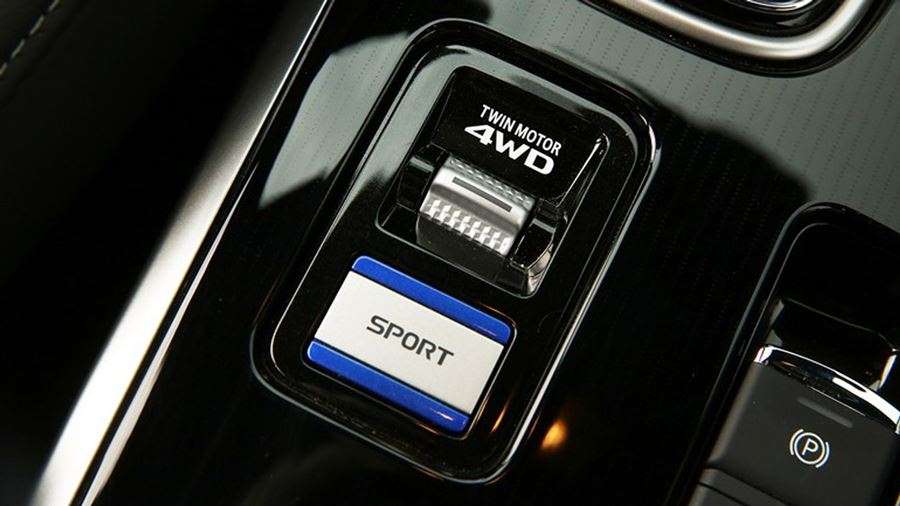
Which sounds great. And it is, except not literally. Put your foot down and you’re greeted with a monotone moan very similar to that of the old car, in that uniquely disappointing CVT fashion – lots of noise and not much acceleration. Only now, the noise is just a bit more distant than it used to be.
Funnily enough this isn’t a CVT either. It’s a fixed-gear system that drives power to the wheels, with a hydraulic clutch to modulate the electric twist provided by the twin motors. It’s built by GKN – the firm responsible for the Focus RS’s lively rear axle assembly, among many other applications.
The transmission catches up eventually and meaningful movement occurs, but it’s still no thoroughbred. The 0-62mph time has dropped 0.5 seconds to 10.5.
This engine revision plus work on the battery – which gets 10% more power output and total capacity of 13.8kWh thanks to new cells and better management – has allowed Mitsubishi to recalculate maximum electric range, fuel economy and CO2 emissions for the more realistic WLTP testing, and the results are more impressive for that reason. We’re talking 30 miles on electric power, 141mpg and 46g/km. You’re also able to drive faster on electric power – now 84 rather than 78mph.
The trade-off is it takes an extra 30 minutes to charge the car using a 16A/3.6kW charge point – this now takes four hours.
Mitsubishi Outlander hybrid: verdict
The latest Outlander PHEV doesn’t reinvent the wheel, but then it didn’t need to. It’s more relevant now than ever before as the push for plug-ins intensifies. And looking beyond the powertrain, the Outlander remains a decent if unexciting all-round package.
Lexus UX review
Compact crossover is an intriguing, leftfield choice
Seemingly at a relentless pace, the onward march of the SUV continues, as typified by the Lexus UX crossover. Not so long ago, the RX was Lexus’s only SUV, but in short order the British line-up’s been fleshed-out both by the medium-sized NX and the seven-seater RX L. With the UX, Lexus has a smaller model to entice buyers away from the Audi Q3, BMW X1, Jaguar E-Pace and Mercedes-Benz GLA.
It’s the GLA that this Lexus feels closest to in terms of ethos – while it ticks various SUV styling cue boxes with its unpainted dark grey wheelarch extensions and body addenda, the UX nevertheless feels like more like a tall hatchback than a rugged cross-country vehicle, much like the Audi Q2 and BMW X2.
As a result, Lexus loyalists will likely head to the UX from the ageing CT hatchback, or perhaps downsize from the bestselling NX. In fact, Lexus has such high hopes for the UX that it should become the firm’s most popular model, overtaking the UX. It’s also expected to be the most important model for the brand in terms of getting new customers into the Lexus brand.
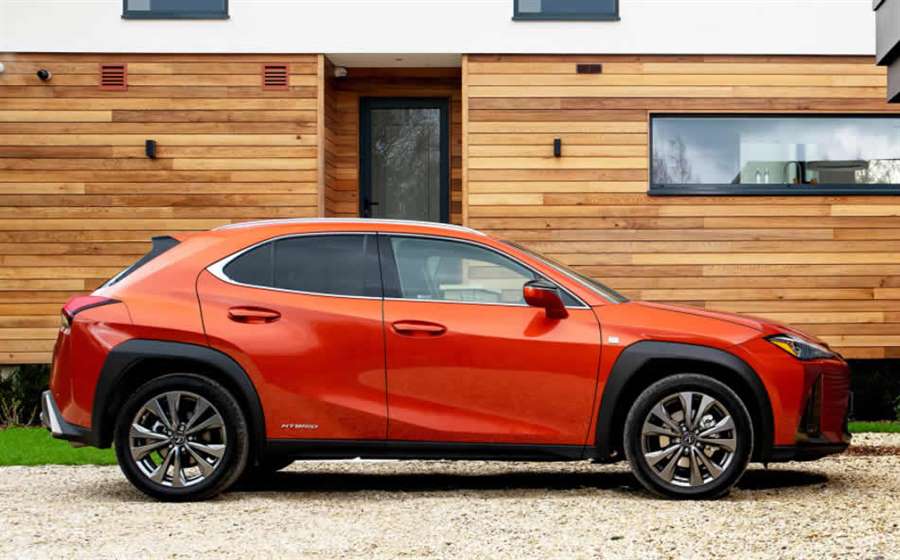
Interior stylish and well made
You won’t mistake the UX’s cabin for the Teutonic look of its Germanic rivals or the so-so quality from its Jaguar Land Rover alternatives – this is undoubtedly a good thing and we like that Lexus continues to plough its own furrow. Material quality, fit and finish is deeply impressive, with a variety of complementary materials giving the dashboard a broad, low, layered look.
Less successful is the continued application of the touchpad for controlling the multimedia system – it’s simply not as intuitive as its rivals’ systems and in some regards is downright infuriating. Still, at least the clock alongside the infotainment screen is a classy analogue number, and not a digital affair shared with a 1980s microwave oven.
Space isn’t the UX’s strongest point however. While there’s enough room up front with an excellent, low-feeling, cocooning driving position, space in the back is no better than adequate. Compared with something like the Audi Q3 which is very impressive indeed, the UX’s sleek roofline and smaller dimensions mean there’s only enough room for two average-height adults. Any taller or wider and you’ll be struggling, especially if there are taller occupants in the front.
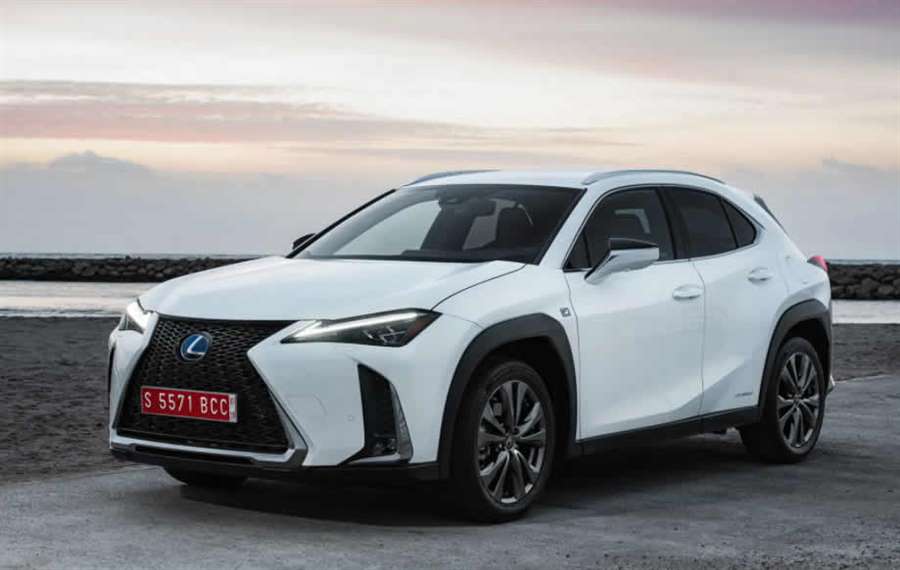
Lexus UX 250h the only engine option
Although a petrol-only UX 200 is available in other European markets, the UK cars will be exclusively hybrid-powered – all models sold in Britain will be badged UX 250h.
Despite the numbering system suggesting otherwise, the 250h is powered by a combination of an all-new 2.0-litre petrol engine, with Lexus’s fourth-generation of hybrid technology. Together they produce 178hp and 202Nm of torque, driving the front wheels. Its top speed is electronically governed to just 110mph, while the claimed 0-62mph acceleration benchmark requires just 8.5 seconds.
There’s also a four-wheel drive version of the UX available – badged E-Four – but this is expected to be a small seller. It also has some practicality issues in that it shrinks the boot down to just 283 litres from 320 litres – no better than a small supermini. Around town, both versions are very civilised and hushed, only getting noisier when you accelerate harder.
It still sounds like the engine’s spinning faster than the rate of acceleration suggests it should be, but this soon subsides. The gentler, more progressive you drive it, the more relaxed it feels. And sounds.
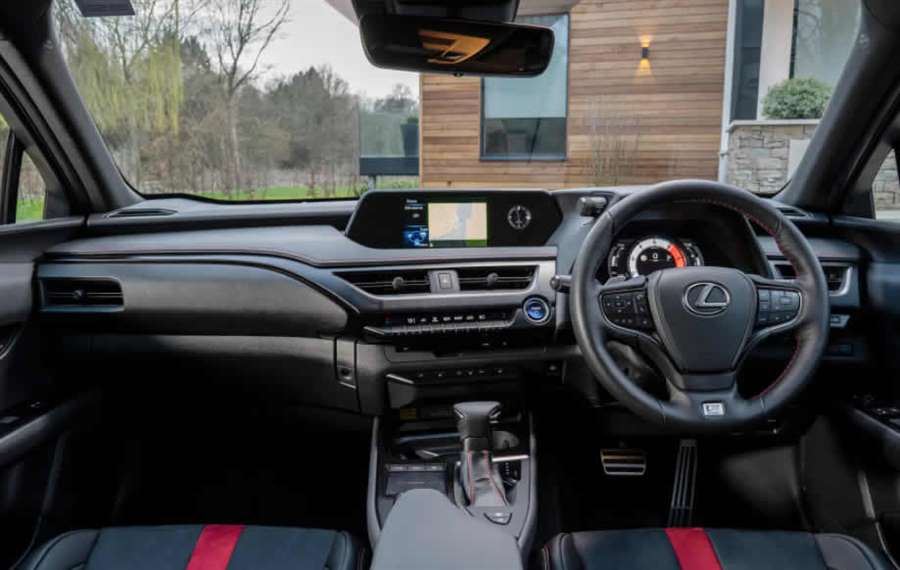
How economical is the UX 250h?
Lexus has yet to confirm the exact fuel efficiency and emissions levels of the UX range, but under the more real-world-imitating WLTP testing method they don’t look immediately impressive. Stick with a front-wheel drive UX 250h and fuel economy ranges between 49.6mpg and 53.3mpg, and claims CO2 emissions of 131g/km.
At the other end of the scale, a UX 250h F Sport E-Four riding on 18-inch rims delivers equivalent figures of 46.3-48.7mpg. Lexus has no immediate plans to release a plug-in hybrid version of the UX – for the time being the 250h is what its manufacturer refers to as a ‘self-charging hybrid’.
Lexus UX practicality and boot space
Lexus’s engineers wanted the UX to have a coupe-like feel and to a certain degree they’ve been successful in this aim, although not always to the benefit of passengers. You sit low down, lowering the car’s centre of gravity, but because the window line is also quite high – you feel more hemmed-in than behind the wheel of a BMW X2 or Range Rover Evoque, for instance.
Space-wise the front chairs have ample room for limbs and heads, and also prove very comfortable – it’s possible to spec them with heater and cooling air conditioning fans. F Sport-spec seats are slightly pinchier at the hips, but in no way uncomfortable. Spare a thought for those in the back, though – it’s not especially roomy and tall passengers will struggle for both head- and legroom in particular. Three adults abreast on the rear bench will prove unpopular and uncomfortable, although the transmission tunnel is quite small.
Even getting in and out of the back seat is a bit of a challenge, with quite a narrow door aperture. Pre-teens aren’t likely to have anywhere near as much bother, and arguably if more space is required, there’s the NX above the UX in Lexus’s SUV hierarchy.
That cosy interior comes partly because the UX is a compact car. It’s smaller than an Audi Q3 – more like the Q2 in size, and as a result is very easy to manoeuvre. Reversing cameras and parking sensors are standard which help, and visibility is good looking forwards and to the sides thanks to slim A-pillars.
Turn around and the angular body work lends a more restricted view out of the back – making it a little trickier to manoeuvre than its Audi rivals. However, those extra assistance systems help to negate this. On the plus side, the UX’s turning circle is nice and tight, so manoeuvring in tight spots is very simple.
Practicality is also hampered in the boot, with a high loading lip and a shallow depth between the boot floor and the flimsy luggage cover. On front-wheel drive models this load level can be lowered to a space beneath, expanding to 320 litres, but it’s very shallow when it’s in place and in line with the loading lip.
Those cars fitted with E-Four come with this as the only boot set-up – the shallow one that even saw a medium-sized holdall digging into the load cover. In this form, boot capacity is just 283 litres which is worse than many small superminis.
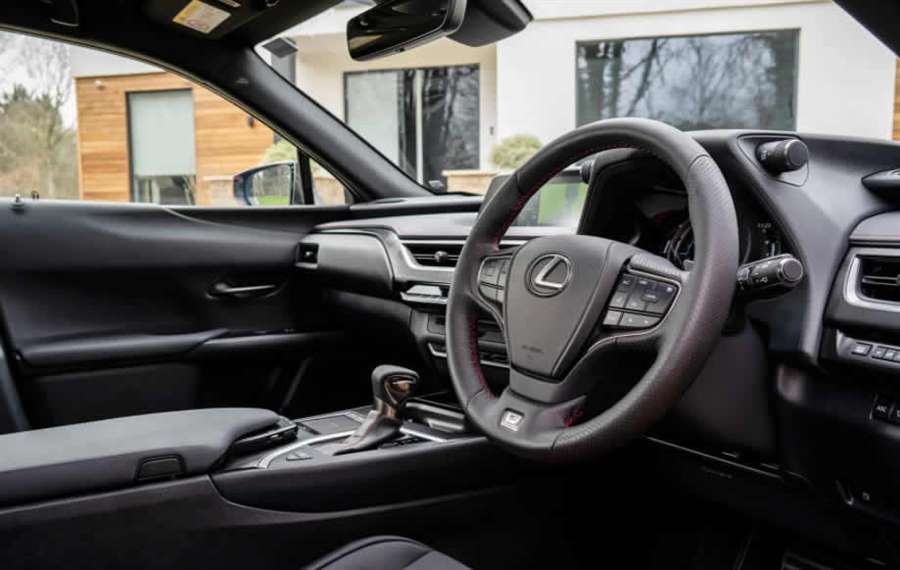
How safe is the UX?
Thanks to standard-fit Lexus Safety System, the UX boasts some impressive safety credentials that have contributed to its five-star rating from Euro NCAP. The suite of driver aids and safety kit consists of:
On top of this, the UX comes with eight airbags, various braking and traction systems, hill-hold assist and the option of adding blindspot monitors and rear cross-traffic alert. For families, there are two Isofix points in the rear as well.
Lexus UX interior and comfort
The design of the UX’s interior matches that of the exterior. There are plenty of varied angles and design features, but we’re pleased to report it’s very high quality with an expensive feel. It’s also less daunting to operate than you might expect, although the media system is a source of frustration like it is in the brand’s other models.
Getting comfortable is very easy indeed thanks to a wide range of seat and steering wheel adjustment. You don’t sit especially high up like you’d expect of an SUV – there’s more of a hatchback feel to the UX. However, you feel hunkered down with the cabin swooping around you, and is a very pleasant place to be.
Whether it’s the seats, the door panels or the top of the dash, the materials used are high quality for the most part, even if there are various different materials and textures used.
Our biggest issue with the interior of the UX – at least in the front – is the media system. The large screen is bright and easy to view as it’s set on top of the dashboard, but the way in which it’s operated is via a frustratingly dim-witted touchpad located on the centre console. It requires greater precision than a rotary controller or touchscreen, and can be quite distracting. The system itself just looks a little dated, too.
Is it comfortable?
The UX may well look like a sharp, sporty off-roader, but the good news is that it doesn’t ride like one. Lexuses are famed for relaxed, comfortable drives – while remaining balanced and composed – and the UX is very much the same.
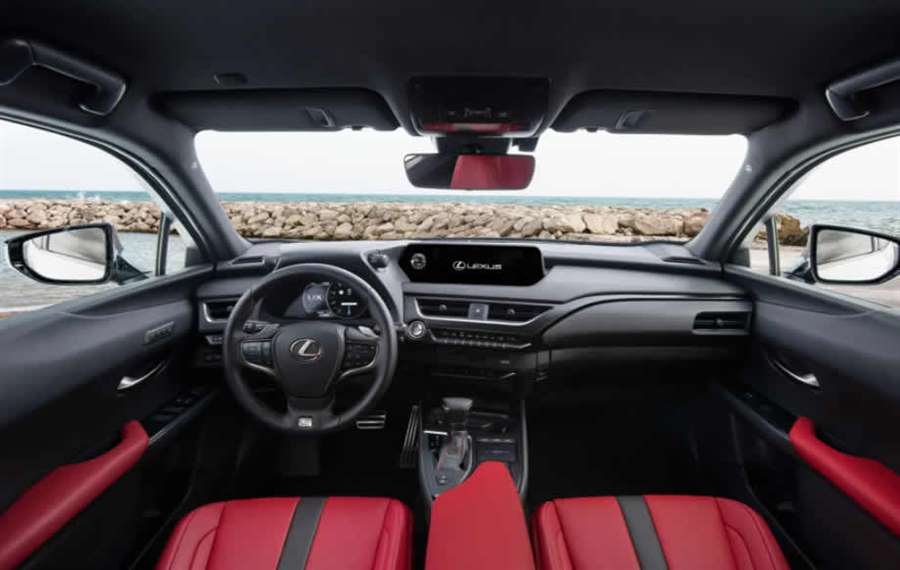
Refinement is excellent which means long journeys are easy and chilled for all, while the seats on all models are excellent. Both supportive in all the right places and very comfortable (with plenty of adjustment) it’s a doddle to get comfy and stay comfy.
Those in the back may find it a bit of a squeeze which impacts comfort levels, but there won’t be too many complaints about the way the UX rides over bad surfaces. Only F Sport models have a slightly more fidgety ride, but even on larger alloy wheels it’s a more relaxed affair than in an Audi Q3 S Line, for example.
Cars fitted with smaller wheels and/or the Adaptive Variable Suspension option offer a very composed ride, with adaptive suspension that is tweaked based on the driving mode you’re in – with a choice of Eco, Normal, Sport and Sport S+. Leave it in Normal for the most relaxed ride.
Lexus UX running costs and mpg
With just one engine available, it’s easy to sift through the UX’s economy figures. For the front-wheel drive model, Lexus claims between 49.5 and 53.2mpg. The lower figure is for cars on smaller alloy wheels.
Go for the E-Four version and there’s only a small penalty – claiming between 46.3mpg and 47mpg.
It shouldn’t be too difficult to get near these figures in everyday driving – as long as you’re not revving the nuts off it.
As with fuel economy, the UX’s CO2 emissions figures are easy to decipher, with just two variants of the same engine.
Tested on the new WLTP emissions cycle, the best-performing UX for emissions comes in at 120g/km, while the worst offender is just over 130g/km – figures that are more than competitive with the majority of its rivals.
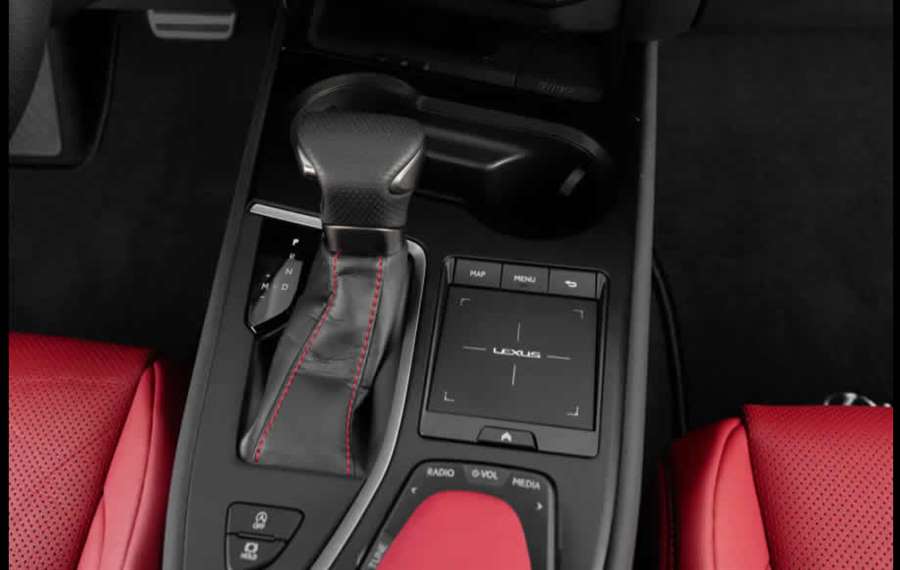
Is it reliable?
Despite featuring a new hybrid powertrain, there’s little reason to expect the UX to be an unreliable car to own. Lexus has a stellar reputation for building cars to very high standards – with some incredible attention to detail that they call ‘Takumi Craftsmanship’. This features things such as windows that slow down before they close to make less noise, and exhaustive testing of the way the doors shut to ensure it’s a solid-sounding noise.
In terms of mechanical components, Lexus has been building hybrids for years, so the technology used should be top notch and very well tested.
Lexus UX engines and performance
Performance is delivered by just one engine – a 2.0-litre petrol hybrid badged UX 250h with 184hp and 190Nm of torque. Lexus describes it as a self-charging hybrid, which basically means you don’t need to plug it in and it sorts itself out which mode it’s in.
The most popular version is the front-wheel drive model, and this will take 8.5 seconds to complete the 0-62mph sprint. Go for the E-Four four-wheel drive model and this drops ever so slightly to 8.7 seconds – largely due to the extra weight it’s carrying around.
In reality, the UX doesn’t feel as rapid as those figures suggest when you floor the throttle. It takes a little while for the engine to get going, but when it does it surges forwards smoothly and without any real fuss. The main thing you’ll notice is the moan from the engine as the revs soar – a characteristic we’ve become used to with hybrid powertrains and CVT transmissions. However it calms down when you’re up to speed, and the UX isn’t the kind of car you’d be thrashing around anyway.
Everywhere else, the comfortable and quiet nature of the UX means it’s very refined and relaxed, while pottering around town allows you to travel for a lot of the time purely on battery power. That means it’s very smooth and silent, with just a little murmur from the engine when it does kick in.
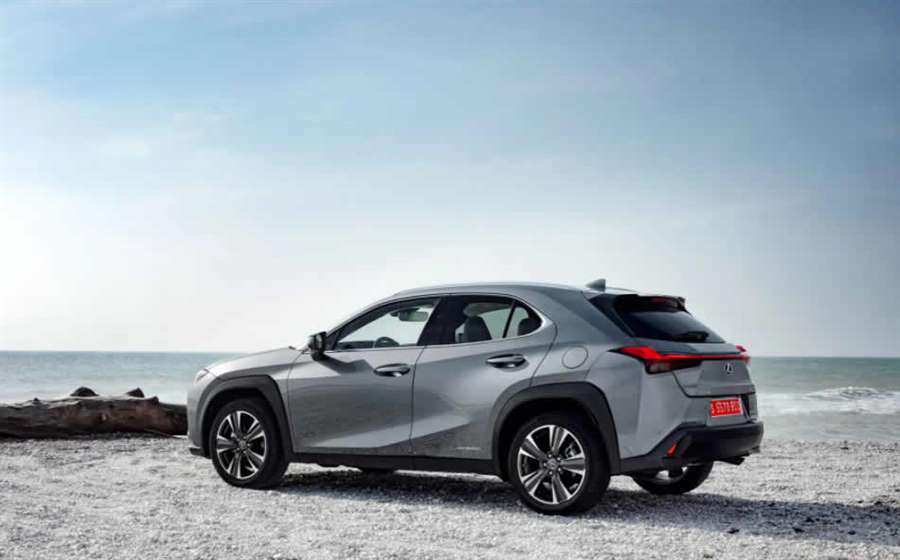
Lexus UX 250h E-Four
The E-Four system directs drive to the rear wheels when it detects the front pair could do with extra traction. Having driven both versions over similar road conditions, we suspect the E-Four package isn’t going to be beneficial to most UX buyers.
Although the UX 250h E-Four has the same top speed as its front-wheel drive sibling (110mph), the extra weight of the system slows the 0-62mph time a shade to 8.7 seconds.
Lexus refers to the hybrid UX’s gearbox as an electronic continuously variable transmission, but it’s not a CVT in the conventional sense – strictly speaking it’s a planetary gear set. Rather than get bogged-down in technicalities, the important thing to know is that it’s less whiny than previous iterations of the transmission.

How does it handle?
The UX performs well around town – the hint is in the name as it stands for ‘Urban Crossover’. It’s very quiet running in EV mode for a lot of the time, but even when it’s not, it’s very hushed. Its small size and tight turning circle make it great for nipping around city streets. Whether you’re in Eco or Normal driving modes, it’s a smooth and relaxed operation.
If you’ve sampled other Lexuses, particularly the CT and NX, you’ll note that the UX’s controls feel weightier. They still feel light around town, but the small amount of extra force you need to haul it about on windier, quicker roads makes it more engaging than its siblings.
While it’s nimble on twisty B-roads, it doesn’t strike its driver as being an athletically enthusiastic sporty SUV. Traction is more than ample – even on front-wheel drive versions – but you don’t find yourself deliberately seeking to carry speed into corners with a view of powering fast out of them – an X1 or an E-Pace perform better in this regard. A lot of this comes because of the hybrid engine that almost holds you back from having too much fun.
F Sport versions of the UX feature larger, 18-inch alloy wheels and stiffened suspension, with anti-rollbars, featuring mid-point dampers to absorb shocks transmitted through the suspension. Over poor road surfaces you’re immediately aware of the firmer compromise – it’s not uncomfortable, and still rides in a far more relaxed manner than an equivalent S Line Audi or M Sport BMW.
Far better to stick with a 17-inch-wheeled UX and opt for the Adaptive Variable Suspension (AVS) arrangement. Here the combination is satisfyingly compliant and seemingly free from uneasy wallowing in corners or under braking. Again, it reinforces that the UX performs more impressively when driven with measured consideration.
Lexus UX long-term test
We ran a Lexus UX 250h for six months, between December 2019 and June 2020. Click the links below to jump to individual monthly reports...
Most car manufacturers are jabbering on about electrifying their model line-ups, some with more ambition than others. But all the while, Lexus has been leading the charge (boo) – offering a hybrid powertrain in every single one of its UK models since 2013.
So while Lexus, or rather its parent company Toyota Group, wasn’t the first to the hybrid game, it’s been the most successful, selling more hybrids than anybody else so far. Yet it’s also proved resistant to change, having yet to launch a plug-in hybrid or pure-electric vehicle and continuing on with what it calls its ‘self-charging hybrid’ powertrain.
To see if it’s still fit for purpose, I’ll be running this for the next six months – a Lexus UX. It’s the smallest SUV in the brand’s four-strong range, and rivals cars such as the Audi Q2, BMW X1 or Volvo XC40.
Self-charging hybrid?
I wanted to tackle this term right away, as it can instil rage into even the most mild-mannered of car enthusiasts online. Type it into Twitter and you’ll find page upon page of not-so-reasoned debate.
Critics say that the term is misleading – it suggests that the car is pulling electricity out of thin air, that it will never need to be refuelled and that all it is is a more efficient petrol car. Toyota says that it addresses buyer’s concerns about hybrid cars – namely, the misconception that you can’t buy one unless you have somewhere to plug it in – and it wants to show that its vehicles do not need external power to perform at their best.
2020 Lexus UX rear three quarter
While I can see where the critics are coming from, I don’t really buy that the average consumer is so thick as to believe the car entirely fuels itself. And though I’m not mad on the term, I can’t really think of a better one that extols the virtues of the powertrain while also communicating that it’s different to a plug-in hybrid.
In addition, I think it's a fairly accurate description. While admittedly all of the power comes from petrol in one way or another, the car charges its battery entirely autonomously - either from the engine or through regenerative braking and coasting.
So there. I’ll be calling this UX a self-charging hybrid throughout these reports. Ner ner ner.
So what’s it actually like?
Superficial things out of the way first – the UX’s design is an acquired taste, but I love the combination of Celestial Blue metallic paint and cream leather that our car rocks. It certainly stands out, with bodywork covered in violent cuts and creases, the aggressive ‘spindle’ grille and a full-width element at the rear providing plenty of interest.
This is a base-spec UX, but it’s fitted with two really important upgrades – the Premium Plus Pack and the Tech and Sound pack. These are pricey options, weighing in at £4,200 and £1,900 – though you can’t have the latter without the former.
2020 Lexus UX interior
They add plenty of luxury kit, though, which I reckon is fairly essential on a premium-badged model such as this. In fact, for the £6,100 total you get 25 new features – not a bad ratio. They include keyless entry, all-round parking sensors, heated and electrically adjustable front seats, 18-inch alloy wheels and privacy glass, which are all useful touches.
Naturally, as a bit of a tech geek, I’m more interested in the wireless charging pad, digital dashboard, head-up display and 13-speaker Mark Levinson stereo system. I can confirm that it sounds absolutely mega.
I’ll admit to being slightly less enthusiastic over the prospect of six months with Lexus’ infotainment system. More on that in a future update, but for now, all you need to know is that it took three fairly experienced automotive journalists around 10 minutes to figure out how to turn the sat-nav’s voice commands off.
Our UX also lacks Apple CarPlay and Android Auto, though there’s great news on that front – 2020 model year cars come with the software installed, and it’s an upgrade that will be applied to our car at its next service. Toyota Group has dragged its heels on this smartphone integration for years, and it’s fantastic to finally see it become available.
Speaking of service, Lexus has supplied us with a car with a few thousand miles on to begin with – it’ll require a trip to the dealers during our term with it. This is great, because it means I’ll get to experience Lexus’ legendary service department first-hand and see if it really does live up to expectations.
Any other disappointments?
I’m a bit miffed that this base-spec model still uses halogen bulbs for indicators – they rather spoil the futuristic aesthetic Lexus is going for with the styling, and I think it’s stingy given this car’s near-£30,000 starting price.
Practicality has already proven an issue. The boot is unbelievably shallow, to the point where even a standard-sized bag of shopping pushes into the parcel shelf. The official figures list the boot space as more than 300 litres, which I take with a grain of salt – there’s certainly less usable space in there than in most superminis or even city cars. It’s not a patch on the likes of the Volvo XC40.
The powertrain is often a sticking point with Lexus hybrids – some love its relaxed nature, others find the sometimes unpredictable nature of the transmission a bore. I’m beginning to lean more towards enjoying it, but there are still times when I yearn for the more enjoyable performance you’d get from a similarly powerful turbocharged petrol engine.
First impressions
I’ve gone through just shy of 1,000 miles over my first month with the UX – a mixture of short runs to and from work and longer cross-country trips. It’s given me plenty of food for thought, but overall it’s proven a surprisingly likable car so far.
But watch this space for greater detail, as there’s plenty more to dive into during our six-month term.
Update 2: Performance and handling
Lexus is a brand known for comfort, stunning build quality and impeccable customer service. That’s not to say all of its models are sedate hybrids, though – cars such as the LC, RC F and even the LFA prove that Toyota’s luxury arm can do ‘exciting’ when it puts its mind to it.
So, did any of that expertise get called up when Lexus put together the UX? After all, small SUVs – especially fashion-led ones like this UX – are bought by young, vibrant types... in theory. Certainly from my perspective, as a single 26-year old (albeit somewhat lacking in vibrancy), I'd like a car that's good fun to drive. And happily, I can report that, within its own confines – being a hybrid, automatic SUV – the UX is pretty good.
How good can a self-charging hybrid SUV with a CVT actually be?
It’s all about driving within the car’s limits. Put your foot down all the way and you’re in for a rough time. The continuously variable transmission sends the revs spiking as the engine desperately spins up to try and conjure some forward momentum. You could even flick the car into Sport mode and take control of some artificially created gear ratios. But once again, this is a practice full of sound and fury, signifying nothing.
Instead, I’ve found the ideal level of throttle input. Place your foot at about 70% and the electric motor and petrol engine work in sync to bring progress that’s genuinely rapid, yet refined. It’s rather like riding the wave of torque that you get with a diesel, but without the associated tractor-like thrum.
In fact, it’s rather easy to trivialise the fact that the UX really is quite a quick little thing. At full chat, 0-62mph comes about in just 8.5 seconds – the same as an Audi Q2 35 TFSI. Not too long ago, that would have been considered hot hatchback pace.
Hybrid handler
The UX certainly doesn’t handle like a hot hatchback, but that doesn’t mean it’s not good fun. It’s remarkably poised in the corners, and you can carry a fair degree of speed without the car feeling as though it’s on the edge of disaster.
The rear end in particular feels surprisingly communicative – a surprise, for a small SUV. As ever, the steering’s remote and over-light, but that’s par for the course among this car’s competitors.
Relaxed manners make cruising a pleasure
Yet the UX doesn’t encourage spirited driving, and so my average pace has steadily dropped back. I still keep up with traffic, but this car benefits more and more the smoother your inputs become. Drive it carefully and you’ll see the little ‘EV’ symbol light up on the dashboard, signifying that the petrol engine’s been switched off and, for this limited period, you’re not using any fuel at all.
In fact it’s immensely satisfying to see how often, and how long I can get the EV light to stay on for. There’s a knack to it – you need to lift off the accelerator just enough, as if you were encouraging an automatic car to shift into a higher gear. The last mile or so of my commute is a straight 30mph cruise through my village, and I’m now capable of doing this reliably on electric power alone. So it’s disappointing that, despite all this battery-powered motion, I’ve yet to crack 46mpg since the impressive first month…
Surprisingly for a hybrid – and I say ‘surprisingly’ because these powertrains are usually at their best around town – the UX is a pleasure to drive on the motorway. The engine has more than enough poke for overtaking at faster speeds, wind, road and engine noise are all well-contained, and the supple ride glides over all but particularly rough surfaces.
The adaptive cruise control and lane-keep assist functions aren’t quite as slick as they were on my previous long-termer, a Honda Civic, though. The cruise control is particularly easily perturbed – even with the following distance at its closest setting, it panics and slows the car down long before I get anywhere near the car in front. The lane-keeping aid, meanwhile, tends to spend all its time twitching the wheel, which is very tiring. I’ve had these both switched off for a while in favour of driving ‘analogue’.
Fuel economy: 45.8mpg
Update 3: A mid-pandemic service for our Lexus UX
In line with COVID-19 lockdown regulations (and acknowledging that my job here at Parkers, while important, doesn’t make me a key worker) I’ve been hiding out in my spare bedroom for the last six weeks, working from home and allowing my long-term Lexus UX to gather dust outside but for a weekly trip to the supermarket.
Lockdown couldn’t have come at a worse time either, at least where the car is concerned. It was due its first service, at 10,000 miles or one year old – and I’d just booked it in for March 25 when the country locked down, on March 23. Bugger.
Of course, a short delay on a service interval is hardly a big deal. This is pre-emptive maintenance rather than a particular necessity, and it’s a very badly built car that will go bang if it misses a single scheduled service. The vast majority of car manufacturers have in fact extended their service intervals for the duration of the lockdown period, promising that drivers don’t need to worry about voiding their warranty for missing a scheduled service.
This act has the additional benefit of freeing up space in service bays for key workers – those still working who may need to drive, and for whom a well-maintained car is particularly important.
Some free slots for service still available
Still, I can only assume that the technicians at the Lexus dealer were twiddling their thumbs, because they called me offering a service slot, should I want it. They stressed that I didn't have to take it, though. Toyota's official stance is it will take a 'sympathetic and flexible' approach to servicing during the pandemic - and if I had concerns, I could delay the service.
I accepted, however, for a few reasons. First, and very selfishly, I desperately wanted to get out of the house – having been cooped up alone for almost two months, the deep but one-sided conversations with my dishwasher were beginning to wear rather thin. Second, I was very encouraged by how seriously Lexus was taking cleanliness and social distancing protocols.
And finally, I intended to sign up to the next wave of NHS volunteers, having already used the car to deliver a few lots of groceries around town – and didn’t want the excess mileage to be a problem.
It’s strange how unnatural driving feels, when you’re back at the wheel for the first time in a while. The trip to my ‘local’ dealer in Cambridge (I live 40 miles away, but my nearby Toyota dealer won’t touch Lexus) took a good hour, and felt deeply weird until I got my head wrapped back around the sensation of speed. It was as uneventful as you’d expect, the UX proving as comfortable and refined as ever.
Social distancing like a pro
Lexus was operating service slots in 15-minute intervals to prevent customers from coming in contact with each other. There’s zero contact with the staff, either – I was invited to sanitise my hands and my car key before placing the latter into an envelope and leaving it on the table. I then collected another envelope with the keys to my courtesy car: another UX, freshly sanitised. Returning was the reverse of this.
The process was quick and reassuring, and though there’s no way to totally mitigate the risks of this virus the procedures in place certainly go a long way to minimising it.
As expected, no warnings were thrown up from the service. All went ahead as planned, with the exception of one thing – I’d been assured an update for the infotainment system would be available, adding Apple CarPlay and Android Auto to the UX’s central screen, but this didn’t materialise. It’s a shame, as the drive reminded me how sub-par Lexus’ system is. Even my courtesy car, fitted with an upgraded setup and a larger, higher-resolution display ran the same awkward system, making it no easier to use.
However, as a first-time recipient of Lexus’ legendary customer service, I was left very impressed. Hopefully the next time we meet won’t be under pandemic conditions…
Fuel economy: 43.5mpg
Update 4: Practicality
One of the key factors that appeals to buyers when opting for an SUV is the promise of space – lots of room in the back seats and in the boot, especially compared with an equivalent hatchback. That’s why in many cases they’ve replaced MPVs in manufacturer line-ups.
Lexus has never sold an MPV in the UK, though, and while many of the brand’s larger cars are immensely practical it’s not a particular brand hallmark in the way it is with, say, Honda or Skoda. Despite this, the UX still falls some way short of the practicality I’d hope to find on a car such as this.
Cramped in the back
Front seat passengers are treated very well, but space in the back is a little more limited. There’s sufficient knee and head-room for adults, but four six-footers will definitely feel cramped. That’s a complaint we can make about the majority of compact SUVs, though.
What makes the UX especially bad, however, is the uncomfortable centre perch, and the high window line and aggressively tinted rear glass that make it very dark and cave-like in the back, despite our car’s light leather.
Passengers have also made a curious complaint – that the subwoofer for my car’s (wonderful) Mark Levinson sound system reverberates through the seat, buzzing against their backs and making even short journeys incredibly irritating. I can’t say it’s an issue I’ve experienced myself, even on the few journeys I’ve spent as a rear-seat passenger – but it might be something to consider if you’re buying this car with the intention of regularly transporting people in the rear.
Any issues with the rear seat pale in comparison to those with the boot, though.
Boot? What boot?
The UX’s boot is laughably shallow, to the point it would probably stop me – even with my limited demands on a car’s boot – from buying one. Overall boot capacity is just 320 litres – smaller than a lot of superminis, and much smaller than the 470 litres of a BMW X2 or 405 litres of an Audi Q2.
It’s a long, wide and flat space, but there’s so little space underneath the parcel shelf that even a small bag of shopping ends up squashed.
That must be why Lexus opted to fit a flexible, fabric parcel shelf, rather than a rigid one. This conforms itself to whatever’s placed under it, though, leaving a rather unsightly bulge in the rear-view mirror…
The big problem is that Lexus was forced to fit the car’s standard 12V battery back here. It sits just behind the rear wheelarch, and artificially raises the boot floor to this insane level. As a side benefit, you do get a reasonably-sized hidden area underneath the boot floor, but I’d trade that in for more overall height.
At least the seats fold easily and lay almost completely flat, so it’s not as awful at the trademark IKEA run as it could be.
Is it really a problem?
Limited rear-seat room can be disregarded for a lot of small premium cars like this, as they’re often bought by single people or couples who value style over space. The boot, however, is ridiculous – even a supermini can accommodate a weekly shop for two without needing the parcel shelf to be removed.
It’s certainly a feature I’d recommend looking very carefully at before opting to purchase the UX.
Fuel economy: 45.1mpg
Update 5: interior & technology
I have a pretty extensive mental list of things in a car’s interior that I enjoy, and things that annoy. Like one of those couples on Escape to the Country who demand six acres and a large characterful kitchen-diner, I’m looking for a few specific items – but can be easily put off by an avocado bathroom suite.
The first is the seats. I like long seat bases to support my long legs, plenty of back support – but not too huggy around the thighs. Tick, tick, and a big Lexussy tick here – the UX, like most Lexuses, has fantastic seats. They’re superbly comfortable and very supportive.
Dials and gauges can make or break a car’s interior. After all, nobody wants information overload, but at the same time it’s tiring to be forced to scroll through multiple sub-menus just to see your remaining fuel, for example. Here’s another area the Lexus does well – its dynamic, part-digital dials show plenty of information, with a small panel off to the side which holds driving data. It’s easy to navigate and attractive to look at. Top work.
You’d hope for excellent build quality with Lexus, and I’m happy to report that even on the little UX everything feels well screwed together with no squeaks, rattles or buzzes at speed.
I’m not one to get dewy-eyed over soft-touch plastics, but the Lexus uses them where it makes sense – with all the places you touch being cushioned and pliable, while surfaces lower down the dash are less so.
Tech all works well
My UX is a base model, but one that’s fitted with the Premium Plus Tech and Sound pack. This brings loads of stuff I reckon is essential if the UX is to compete with cars like the Mercedes-Benz GLA or Audi Q2. Electric adjustment and heating for the front seats, keyless entry, all-round parking sensors should, I think, be standard equipment anyway – while the leather upholstery, high-powered Mark Levinson stereo, head-up display and wireless charging are all nice extras.
The stereo in particular sounds excellent, with deep bass, great clarity and more volume than is strictly necessary. It’s a shame that the infotainment system it’s attached to is so rubbish, though – playing music through Bluetooth feels mighty old-fashioned when competitors allow you to connect Android Auto and scroll through to your heart’s content.
Anything you’re missing?
Well, the 7-inch infotainment screen looks a little bit lost in its surround. Higher-end UX models have a 10.3-inch screen, which means the housing has to be able to accommodate that larger unit. As a result, my car has some rather ugly bezels either side and with the text-heavy interface it can be confusing to navigate.
A 360-degree camera would be nice, but the standard rear-view unit works just fine – no need to upgrade as far as I’m concerned. What I do miss is the more sophisticated LED headlights with adaptive high beam – they might illuminate the road slightly more impressively than my car’s basic LED units, which have a very sharp cut-off.
What I’d really like, though, is for Toyota to take the infotainment display from its facelifted C-HR and plop it into the UX. I’ll speak a bit more about the relationship these cars share and which comes out on top in my final update, but in terms of tech the Toyota is leagues ahead thanks to its provision of both a touchscreen and Apple Carplay/Android Auto connectivity.
Fuel economy: 45.0mpg
Update 6: Farewell
After six months and a few thousand miles in the Lexus UX, it’s time to wave goodbye – and collect my thoughts on the time I’ve spent with this premium, hybrid SUV. This obviously wasn’t the typical long-term loan, as it was punctuated in the middle by a nationwide lockdown period. But I handed the car back with plenty of opinions – mixed ones – which I’ll attempt to share now.
Overall? I really like the UX. It’s not quite my favourite of the Lexus lineup – that honour goes to the LC, followed by the RX, because deep down I’m a fancy gal trapped in the body of a cash-strapped journalist. Yet even the UX’s status as the baby of the range doesn’t make it feel in any way budget. Little touches, like the soft-close electric windows, the sumptuously supple leather, the intricate analogue clock on the dash – none of them are what you’d call essential, but they elevate the UX above a similarly-sized offering like the Volkswagen T-Cross.
Looks don’t fade
Divisive – yes. But the UX still looks fresh and I think it’s a particularly smart addition to this market sector.
Lexus UX rear cornering
At night, things only get better. I love the lighting signatures on this car – they’re unmistakably Lexus, yet different to the rest of the range. Full-width taillight elements are becoming more commonplace, but the UX has a particularly clean example. You’ll definitely know if you’re following one of these home.
Great to drive – with caveats
I don’t think the self-charging hybrid system is for everybody. Mechanically involving it is not – even less so than a conventional automatic, so if you like to feel as though you’re innately connected to your car, a Lexus hybrid is not for you. Try a Porsche Macan, or something with a manual gearbox.
But it didn’t take long for me to get used to how the UX proceeds along the road. The electric motor, continuously variable transmission and engine have a pretty harmonious relationship; certainly, some time spent in other manufacturer’s hybrid models has given me new appreciation for how Lexus has tuned its self-charging hybrid system.
It shouldn’t be surprising, really, as parent brand Toyota has been building hybrid cars for more than two decades now…
Practicality still a problem
Truly, the size of the boot was my biggest issue with the UX. I’ve already had a long moan about it above, so I won’t go into it too much here, but I reiterate – any car, even the sportiest of roadsters, ought to be able to cope with a midweek shop for two people. A compact SUV? Well, the bar’s set even higher.
Having normal-sized shopping bags distending the flexible parcel shelf and spoiling rear visibility is something that never stopped grating on me, especially during lockdown when a trip to the supermarket was the only time I drove the car at all.
How much did it cost to run?
Here’s another area the UX left me disappointed – its fuel consumption. I’ve spent plenty of time in Toyota hybrids before now, and I’ve always been incredibly impressed at their economy. A long weekend in a Toyota Corolla 1.8 Hybrid once saw me average over 65mpg with ease – the beauty being that, unlike a diesel, that economy figure is possible even on short journeys.
Lexus UX driving modes
Yet in the UX I’ve never exceeded the 47.9mpg I got during my first month with the car, and over my months it’s averaged out to just 45.5mpg. With official WLTP figures for my two-wheel drive model being a claimed minimum of 49.5mpg, I’m a little disappointed – and I’m certainly no lead-footed speed freak. During its worst month, where a slightly quicker colleague borrowed it, the UX returned just 43.5mpg.
But overall, how does the UX stack up to a closely-related model? Well, that’s where things get awkward, because you see…
I’d rather have a Toyota C-HR
At launch the Toyota C-HR was only available with a rather asthmatic 1.8-litre self-charging hybrid powertrain, so it took until the facelift and the introduction of a 2.0-litre alternative to become a rival to the UX.
After sampling the two back-to-back I have to admit the C-HR is a better car. Though its powertrain is very closely related to the system in the UX, the difference in response is remarkable. The C-HR has a genuine degree more immediacy when you pull away – its handling is keener and its steering rack quicker, too.
You don’t lose much in comfort, either, and the C-HR’s boot is enormous compared with the UX.
The C-HR doesn’t have anything like the interior ambiance that the UX enjoys, but it’s still neatly designed and laid out and – joy of joys – it has Apple CarPlay and Android Auto built in. That’s something new UX’s do get, but the update to install it to my car wasn’t ready before I had to hand it back.
Final thoughts
The UX is good-looking, has a cracking interior, is superbly comfortable on a long journey and is even reasonably good value considering the kit that’s on offer – once you choose a few carefully considered options packs, that is.
Is it worthy of converting buyers of premium German SUVs, such as the Audi Q3, BMW X1 or Mercedes-Benz GLA? I think it is, but whether those drivers would even consider a Japanese car with the quirks of the UX over its Teutonic competition is perhaps unlikely.
Lexus UX front three quarter
I still recommend taking one for a test-drive, though. You never know, you may be drawn in to the world of Lexus – a place where dependability and customer service rule the roost. It’s this, rather than the car itself, that would tempt me into Lexus ownership.
Fuel economy: 45.4mpg
Total average: 45.5mpg
Lexus UX verdict
If practicality is at the bottom of your list of priorities, the Lexus UX is more than worthy of a place on your shopping list if you want something smooth, relaxing and easy to drive that also has some character. It looks great, the interior is plush, interesting, packed to the roof with equipment and has an excellent driving position. It just feels different and a bit special – especially compared with the competition.
While the sole engine option may limit its appeal, the hybrid drivetrain is refined and relaxing around town – which is also where it’s most efficient. The added bonus is that the UX is really quite fun to drive with agile handling and responsive steering, plus it can get up and go if you need it to without fuss and drama.
The Toyota C-HR comes with the same powertrain, though, and costs less to buy and has a bigger boot. It's also just as distinctive to look at and be in. If you want something that's a bit more family-friendly, an Audi Q2 or BMW X2 could be worth a look, but you won't find a hybrid option in either of these ranges.
Land Rover Defender SUV review
"The Land Rover Defender has returned with an incredible repertoire of talents, including a strong range of plug-in hybrid, petrol and diesel engines"
This is the all-new Land Rover Defender, the long-awaited, much-hyped replacement for Britain's most famous SUV. It returns some four years after production of its predecessor stopped, and manages to be both similar and yet significantly different.
Its design clearly pays tribute to the original ‘Landie’, albeit in original new ways, and Land Rover still claims it's the best off-roader you can walk into a showroom and buy. However, its advanced technology, improved performance, luxury and safety kit mean the Defender has been parachuted into the 21st Century.
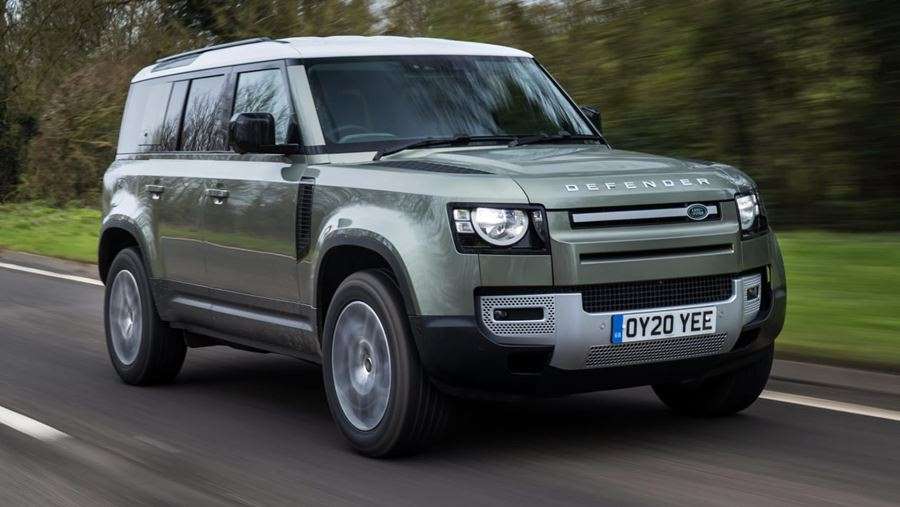
We'll let you decide whether its design is a success, but it certainly looks appropriately chunky, and details like its front and rear lights are impressively intricate. There are plenty of personalisation options too. It may be that you love the basic Defender with steel wheels, but hate the range-topper with gargantuan alloys, or vice versa. Similarly you may prefer the looks of the three-door Defender 90 or longer five-door 110, and there’s an even lengthier 130 also in the pipeline.
Inside, the Defender has a rugged, industrial aesthetic, characterised by exposed bolt heads, metal surfaces and an exposed magnesium crossmember that forms part of the car’s structure. It's also unique thanks to an optional jump seat between the front occupants that can make the 90 or 110 a six-seater. A third row of seats is also available for the 110.
Passengers are treated to the latest in-car entertainment and connectivity, with Land Rover's Pivi Pro system using two modems to ensure it can be wirelessly updated, even while being used for media, navigation or traffic updates.
At launch, a pair of four-cylinder 2.0-litre diesel engines with 197 or 237bhp were available, badged D200 and D240 respectively. These have now been replaced by a pair of 3.0-litre six-cylinder engines with mild-hybrid electrical assistance. In base D200 trim, this engine produces 197bhp, which increases to 247bhp in mid-range D250 spec and 296bhp in the range-topping D300 version.

The entry-level P300 petrol is unchanged with a 2.0-litre four-cylinder engine producing 296bhp. For those wanting more power, a 394bhp 3.0-litre straight-six petrol P400 mild hybrid is also available in the top X trim, but a starting price of £81,000 means it probably won't be a common sight on UK roads.
A P400e plug-in hybrid was introduced as part of the 2021 revisions and is the first PHEV powertrain in the history of the Defender. This model combines a 2.0-litre four-cylinder petrol engine, an electric motor and a battery pack, and is the most powerful Defender available, producing 398bhp.
The PHEV version is the fastest Defender until Jaguar’s Special Vehicle Operations division creates a high-performance V8 model, which is expected later this year. The entry-level diesel costs from £45,000 and every version has an eight-speed automatic gearbox, low-range gears and four-wheel drive.
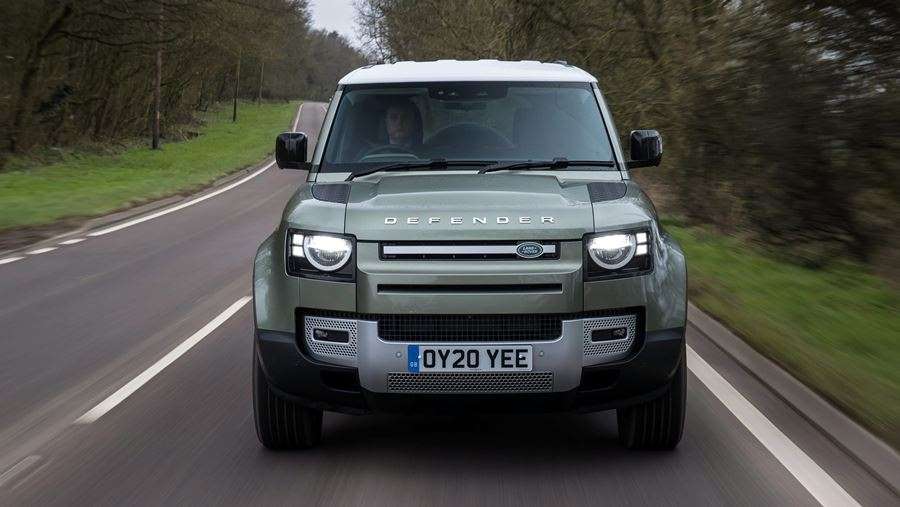
The D240 diesel is capable of getting the Defender from 0-60mph in a respectable 8.6 seconds, but it's the way the Land Rover feels to drive that's most surprising. The steering is direct and responsive, tucking the nose into corners with little hesitation and while there's some body roll, this suits the Defender's character. This is a Defender that's sporty and enjoyable to drive along a twisty road, thanks to the chameleon-like nature of its adaptive air suspension.
Off road, the same setup can extend, providing enough articulation to see the Defender crawl over almost any obstacle and wade through almost a metre of water. It's almost unstoppable off-road, and surprisingly comfortable while tackling the very roughest terrain. It can also tow up to 3,500kg and carry an unbelievable 300kg on its roof.
The Defender has always been innovative, and the latest version is one of the most intelligent cars we've ever tested. It may be rather uneconomical - at least until the plug-in arrives - but it makes up for this with impressive on and off-road manners, and an incredibly well considered design for demanding buyers, their passengers and all their gear.
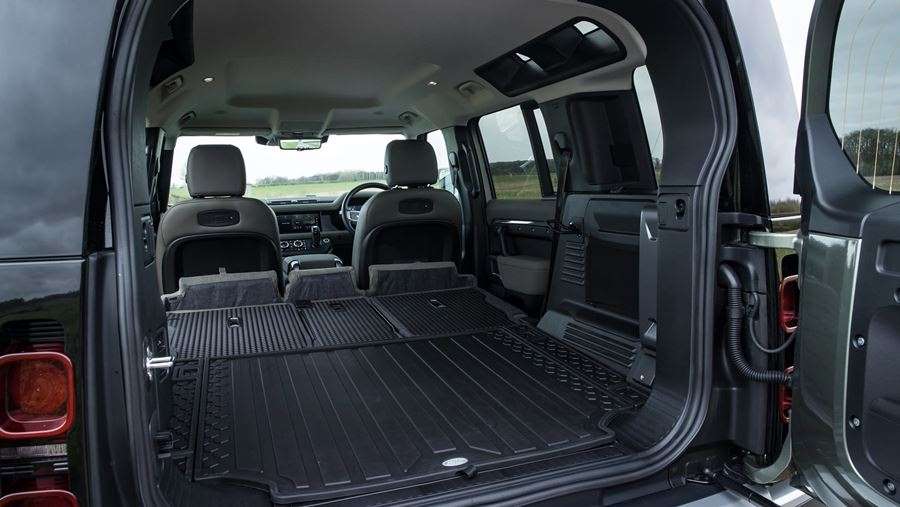
Land Rover Defender SUV - MPG, running costs & CO2
Defender buyers will be able to choose between diesel, petrol and mild-hybrid power, depending on what suits their needs and driving habits the best. Sadly, none provide especially low running costs.
Land Rover clearly prioritised performance, versatility and rugged looks over fuel-efficiency - just as they did with the original. Even the most economical version of the new Defender just manages to tip over 30mpg, while (WLTP) CO2 figures north of 230g/km mean company-car drivers will face a hefty Benefit-in-Kind bill.
Unlike the original Landie, which had the same commercial status as a van or pickup, the new standard versions of the Defender 90 and 110 are classed as private vehicles, with the van-like 90 and 110 Hard Top the only versions to be classed as commercial vehicles. A plug-in hybrid is now available, and we expect a range-topping V8 model to arrive in due course - details of the latter have yet to be confirmed.
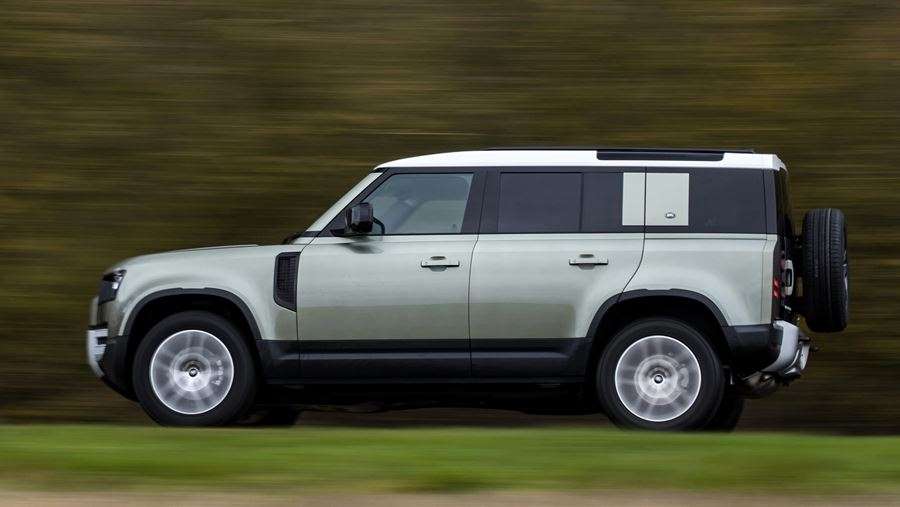
The Defender was launched with two diesel 'Ingenium' 2.0-litre turbo engines badged D200 and D240, returning up to 32.2mpg in the 90 and 31.7mpg in the Defender 110. CO2 emissions span from 230-253g/km (WLTP).
These have been replaced for 2021, with a new 3.0-litre straight-six diesel engine boasting mild-hybrid tech. The D200 version of this engine can manage around 32mpg, a figure which is closely matched by the more powerful D250 and D300 models. All three engines emit 231-233g/km of CO2.
The 2.0-litre turbo petrol P300 can manage around 24mpg with emissions of over 260g/km, the same ballpark figures as the 3.0-litre P400 mild hybrid. Thanks to its 19.2kWh battery pack, the P400e plug-in hybrid can manage up to 27 miles on electricity alone, giving it official figures of 85.3mpg and CO2 emissions of 74g/km. This should make it the cheapest Defender to run by some margin and the only one that should be on company-car shopping lists. It also just qualifies for free entry into the London Congestion Charge zone, sneaking under the current threshold by 1g/km.
The battery can be charged at home using a 7.2kW wallbox, taking it from 0-80% in two hours. It will also be possible to use a 50kW rapid-charger (using the supplied cable), for an 80% charge in 30 minutes.
Insurance groups
Insurance groups for pricey, complex SUVs tend to be a bit higher than for normal cars. That's certainly the case here, because even the entry-level D200 sits in group 31 out of 50, while the D240 First Edition sits in group 38. That's the same rating as the P300 petrol receives in SE trim, while the P400 X is in group 44.
Warranty
Land Rover provides a three-year/unlimited-mileage warranty with its new models, which matches BMW and Mercedes. It's not as generous as some brands, though; the Kia Sorento comes with a seven-year warranty as standard.
Servicing
Land Rover offers servicing plans that can help spread the cost of maintenance, so they're worth exploring with the dealership. It's also worth noting that diesel engines require AdBlue top-ups every so often.
Land Rover Defender SUV - Engines, drive & performance
The Land Rover Defender has a wider range of talents than almost any other vehicle on sale
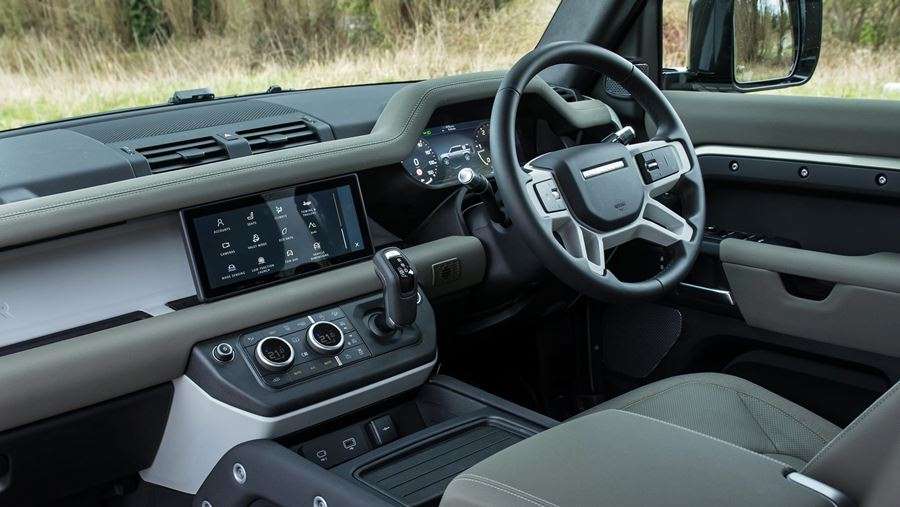
It might be one of the most loved models of all time, but one thing the Defender was never famous for was its everyday performance. Enough low-down grunt to get up steep bank and tow a trailer, yes, but not straight-line speed away from the lights.
With a more advanced powertrain, the new Defender has a far broader set of talents. Its advanced adaptive four-wheel drive and air suspension (on top trims) ensures it's still capable of traversing the world's most inhospitable terrain, but it can also tear from 0-62mph in as little as six seconds.
Just as impressive as its on-paper statistics, there's the fact it's simply fun to drive as well. Many have questioned whether the new Defender would tread on the toes of the Discovery, but from behind the wheel it instantly has a character of its own. Its steering is more alert and faster to react, while the Defender's air suspension is firmer and there's more feedback flowing back through your fingertips and the seat as you drive.
Attack a British road, and the Defender is instantly enjoyable and feels surprisingly sporty, digging its front tyres into the road. It's remarkably composed too; the fact the body leans slightly through faster corners and the nose lifts under acceleration only seems to add to its character.
Yet, the same suspension can transform to scale ruts, wade through deep water and absorb torturous bumps. Every Defender is fitted with an eight-speed automatic gearbox that also has low-range ratios designed for off-road driving and towing. At Eastnor Castle's off-road experience centre, sections have been opened up for the first time in a decade to test the Defender's extreme capabilities. A set of tortuous undulating water-filled pits is a particular challenge, and just when you think the Defender is about to get stuck, its Terrain Response 2 software modulates power to the wheels to find just enough traction to drag it out the other side.
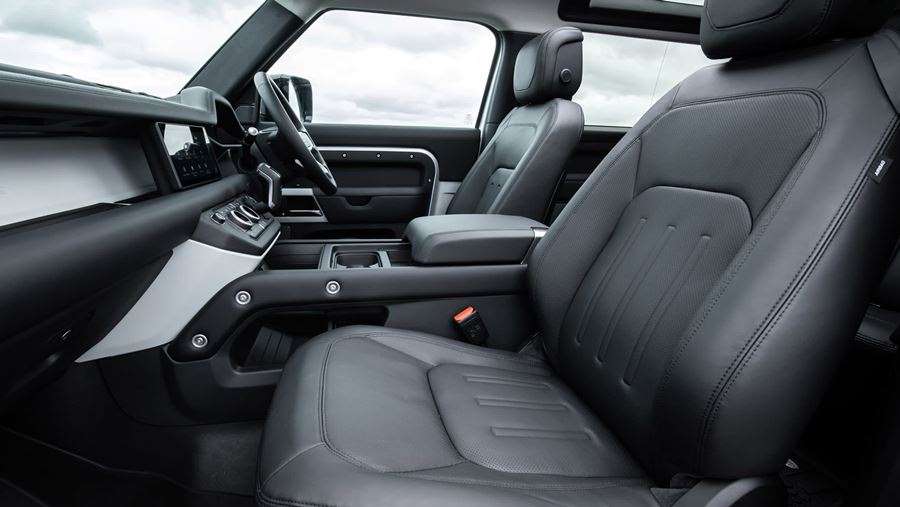
Designed around Land Rover's new D7x platform that's incredibly stiff - and has been subjected to years of rigorous testing during its development - the Defender has approach and departure angles of 38 and 40 degrees respectively, along with a 900mm wading depth. It can tackle 45-degree side slopes and inclines, and its Terrain Response 2 system can be used to adjust the chassis and differentials manually or simply be left in Auto, where it recognises the surface you're driving on.
The Defender launched with two versions of the 2.0-litre 'Ingenium' diesel engine, badged D200 and D240, with the same 430Nm of torque but 197 and 237bhp respectively. Both get an automatic gearbox and permanent four-wheel drive as standard, and cover the 0-60mph dash in 9.9 seconds and 8.7 seconds.
Early impressions are that it's the best use of the engine yet, and we especially like how Land Rover has altered its sound. This has been done by augmenting engine noise using the car's audio system, with the resulting background noise more like a rumble than a high-pitched diesel growl. A sensitive throttle pedal means the D240 engine also feels impressively responsive.
Land Rover is already replacing them with larger 3.0-litre straight-six diesel engines equipped with mild-hybrid hardware. These are badged D200 (with 197bhp), D250 serving up 247bhp and D300 with 296bhp. Acceleration from 0-62mph takes 10.2, 8.3 and 6.7 seconds respectively.
Petrol engines
Unlike the previous iteration of Defender, buyers can choose between two petrol engines, badged P300 and P400. The smaller 2.0-litre turbo gets 296bhp, propelling the car from 0-60mph in 7.6 seconds, while the 3.0-litre straight-six P400 has 395bhp and gets to 60mph in six seconds.
The P400 is also fitted with 48-volt mild-hybrid electrical assistance, designed to harvest the energy normally wasted under deceleration and store it in a small lithium-ion battery. This can be used to bolster the engine's torque under acceleration and provide stop and start more of the time when waiting in traffic.
It's the most fun version to drive, for now, with a tuneful sound from its six-cylinder petrol and impressive acceleration. Interestingly, there are no steering wheel-mounted paddles for the automatic gearbox, as engineers don't feel they fit the Defender ethos, but you can nudge the gearstick to shift manually. The engine and steeringing again feel surprisingly willing for a big, heavy SUV.
Plug-in hybrid engines
The Defender P400e plug-in hybrid uses a 2.0-litre petrol engine, electric motor and a 19.2kWh lithium-ion battery. With a combined 398bhp, it's the fastest Defender available until an anticipated performance model arrives with a V8 engine, getting from 0-62mph in 5.6 seconds. Unfortunately, the P400e is limited to the Defender 110 model. Air suspension and 20-inch alloy wheels come as standard.
Land Rover Defender SUV - Interior & comfort
Former Defender owners won't recognise the level of luxury and comfort on offer
The Defender's interior is like nothing else on the market today, combining retro nods to the original like exposed screw heads and bare metallic surfaces, along with the debut of new technology for the entire Land Rover brand.
As you'd hope, there are also innovations, such as a system that uses real-time camera feeds to offer a view of the obstacles immediately ahead without the nose of the car getting in the way. ClearSight can also be used to provide an uninterrupted rear-view mirror, even if the Defender is loaded with passengers and luggage or the rear window is caked in mud.
Fans of industrial design will adore touches like the powder-coated aluminium surfaces and magnesium bulkhead, the latter being a functional part of the Defender's body structure. It's undeniably tough-looking, and its extreme off-road capabilities are reinforced by the quantity and sturdiness of grab handles for passengers to cling onto. The flat, horizontal shapes are clearly a nod to its predecessors, as is the jutting centre console with a stubby gearlever and oversized switchgear.
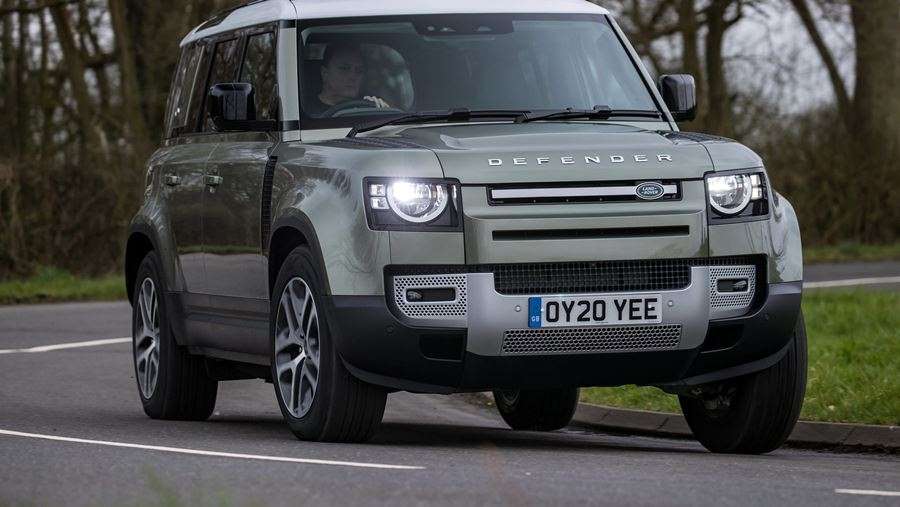
But it's not completely retro; there's a modern aesthetic not unlike the design of the latest Apple Mac Pro. The 10-inch Pivo Pro infotainment system is all new, using dual-eSIM modems that can receive over-the-air software updates and provide media and navigation without interruptions. An auxiliary battery also means it can work in the background even when the Defender is parked up, and resume more quickly. It also supports a mobile app that can be used to interact with the Defender and set the climate control remotely.
Equipment
Land Rover certainly hasn't held back when it comes to offering a wealth of trim levels and customisation options to customers. Even the trim levels are somewhat overwhelming, with Defender, S, SE, HSE, First Edition and X all offered, along with a myriad of options that even extend to what sort of roof you'd prefer.
The standard 110 model comes fitted with rather appealing 18-inch gloss white steel wheels, LED headlights, heated front seats, the 10-inch Pivi Pro system, surround cameras, cruise control and air suspension. S adds 19-inch alloy wheels, leather upholstery and digital instruments, while SE upgrades the headlights with a 'signature' look for the daytime running lights, along with keyless entry, 20-inch wheels and ISOFIX for the front passenger seat. It also adds some key features like a 10-speaker stereo, electric steering column and ClearSight rear-view mirror.
HSE increases the luxury further with a folding fabric roof (Defender 90 only, with a sliding panoramic roof for the 110), Matrix LED headlights, extended leather interior and a heated steering wheel. The range-topping X gets a black roof and bonnet, black exterior trim, orange brake calipers, front skid plate and tinted rear lights. It also has more off-road hardware, but you wouldn't know it inside thanks to Walnut veneer, heated rear seats and a 14-speaker stereo. It's also only available with the most powerful D300 and P400 engines.
Options
It's hard to know where to start with the Defender's options, but rest assured its packs and accessories cover every eventuality, from a tow bar to a ramp that makes it easier for your dog to clamber into the boot.
A good kicking off point is the curated equipment packs called Explorer, Adventure, Country and Urban. Explorer adds the famous snorkel air intake, a roof rack, waterproof side-mounted gear carriers, a matte black front badge and items like mud flaps and a cover for the spare wheel.
The Adventure pack includes an on-board pressure washer (with a 6.5-litre tank) designed for rinsing off boots and outdoor sports gear, scuff plates, mud flaps, and an integrated air compressor. There’s a similar roster of add-ons in the Country pack. In contrast, the Urban pack adds metal pedals to the interior, while rear bumper scuff plates, a spare wheel cover and front skid plate protect the exterior.
Land Rover Defender SUV - Practicality & boot space
Configured wisely, the Land Rover Defender offers serious load-lugging abilities
Like the rest of the Defender's attributes, the practicality on offer is also highly flexible and customisable. The biggest decision facing buyers will be whether to go for the five-door 110 model, or the three-door 90. An even larger Defender 130 with eight seats is also expected to arrive later on.
Land Rover Defender interior space & storage
Choose the three-door 90 and the Defender can still carry up to six people. That's thanks to a unique jump seat between the front seats, made possible by the dashboard-mounted gearlever. It's big enough for kids, and when the optional middle seat isn't in use, folding it forwards transforms it into a large central armrest and cubby. The biggest sticking point is the lack of rear doors because anyone getting in the back has to climb rather high to negotiate the front seats.
The 110 is also offered in a 5+2 layout, which is Land Rover speak for adding two smaller seats in the boot. These are best suited to kids but adults may also be able to travel for shorter hops in a pinch.
There are also handy features like USB or 12-volt power sockets for charging portable devices, a backpack that secures to the rear seat and 'click and go' system for middle-row passengers to attach tablets, bags, laptops and jackets. Then there are innovations like the side mounted 'Gear Carriers' that are 24-litre lockable and waterproof containers that mount on the Defender's rear window pillars in a similar fashion to motorcycle saddle bags.
The five-seat Defender 110 has 1,075 litres of cargo space behind the seats, expanding to a massive 2,300 litres when the seats are folded down. A rubberised floor is designed to shrug off spills and be brushed or wiped clean. The Defender 90 is notably less spacious, with a shallow 397-litre boot that's smaller than a Honda Civic's.
It's worth noting that the Defender has a traditional side-hinged tailgate, not a hatchback like most of the SUVs currently on sale. This can be fairly heavy (it also carries a full-size spare wheel) and will require some room behind the vehicle to open fully. However, it does open on the correct side for UK roads, with the opening towards the kerb, and is a characterful nod towards its predecessor.
Towing
Defenders have long been used for towing, and the latest version is seriously capable. It can pull a 3,500kg braked trailer, and the Defender itself has a maximum payload of 900kg. It can also accept a static load on its roof of up to 300kg.

